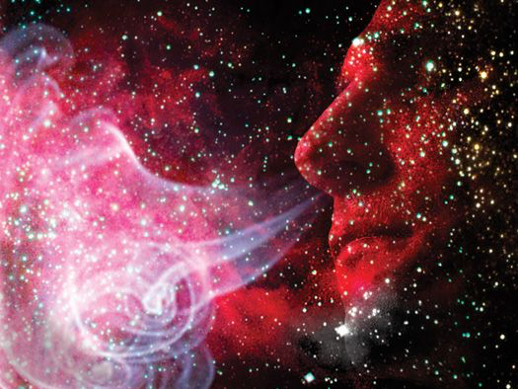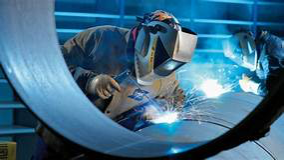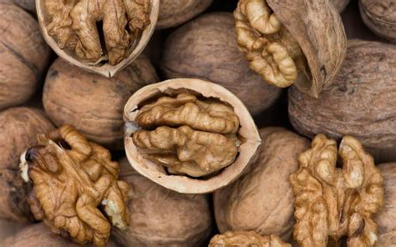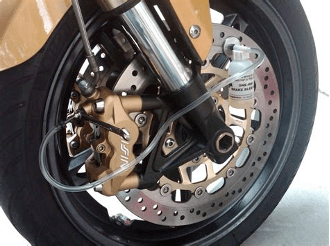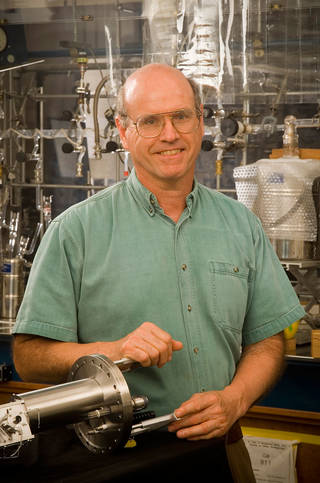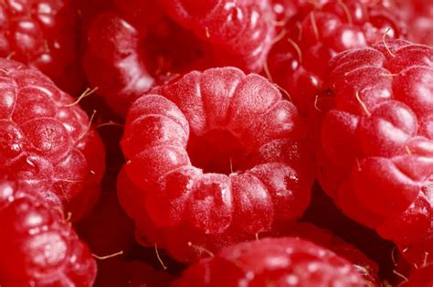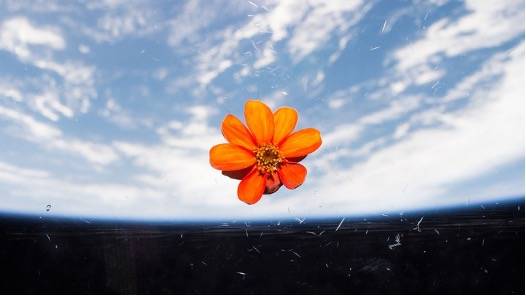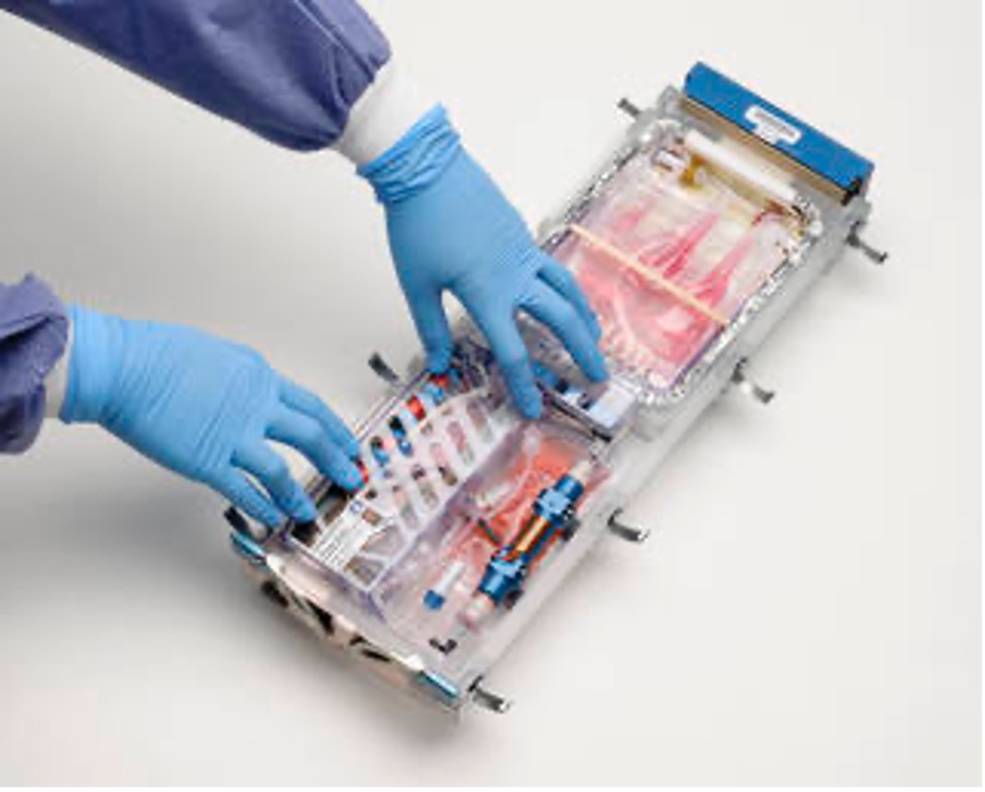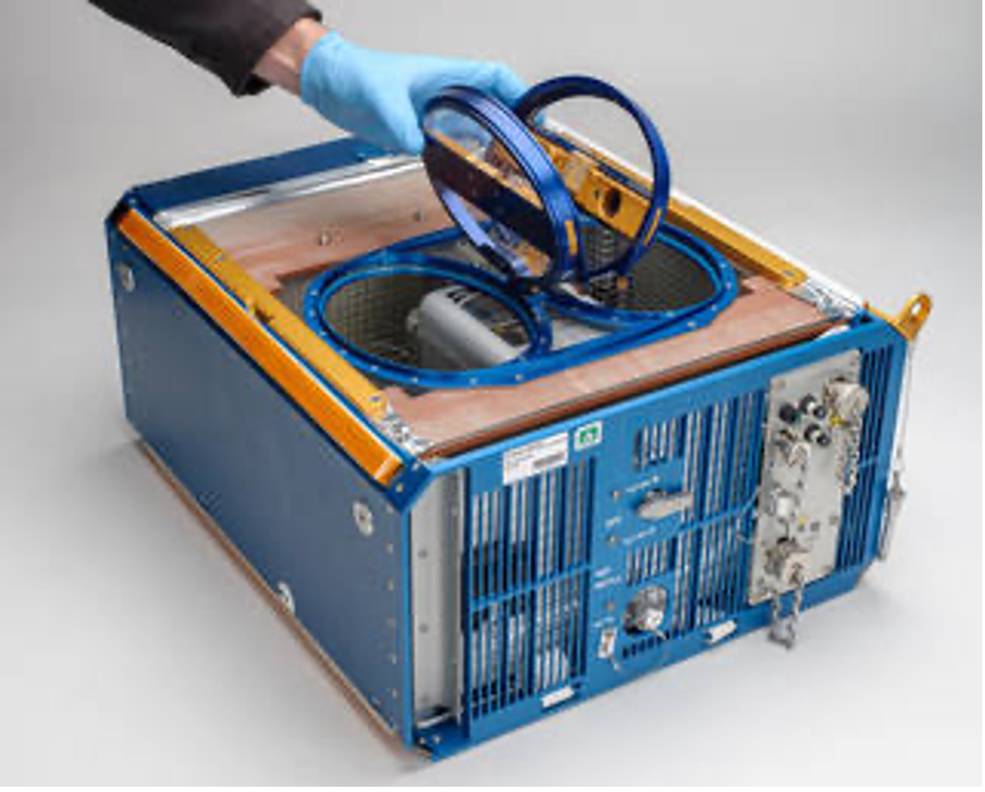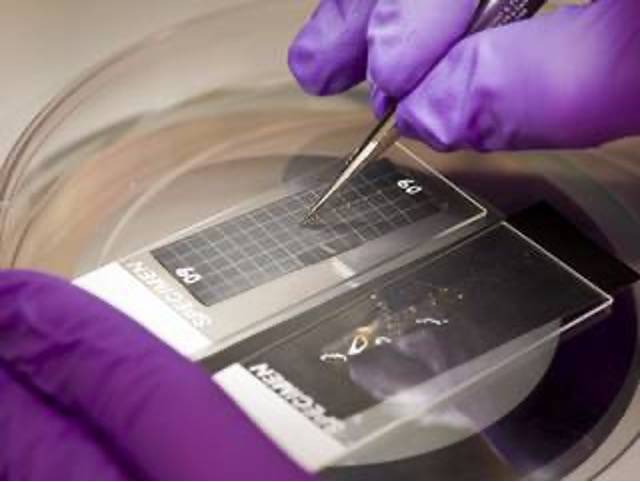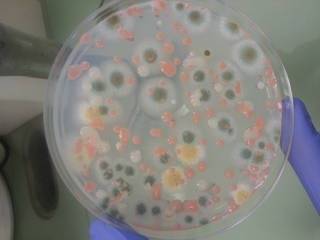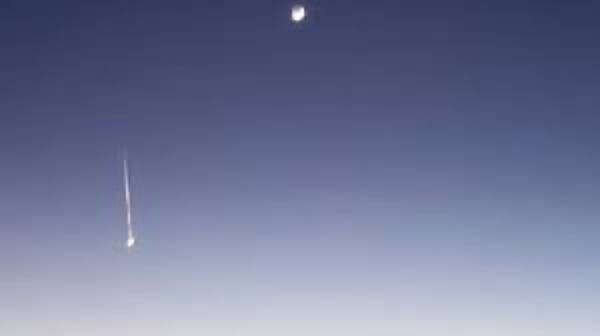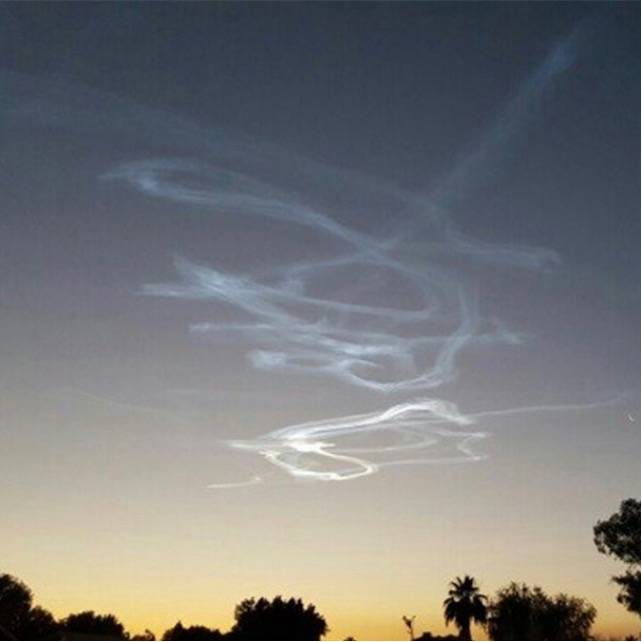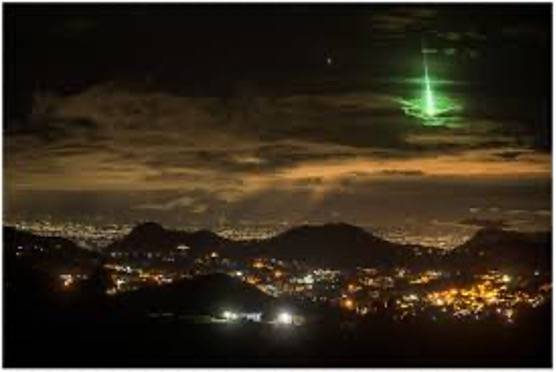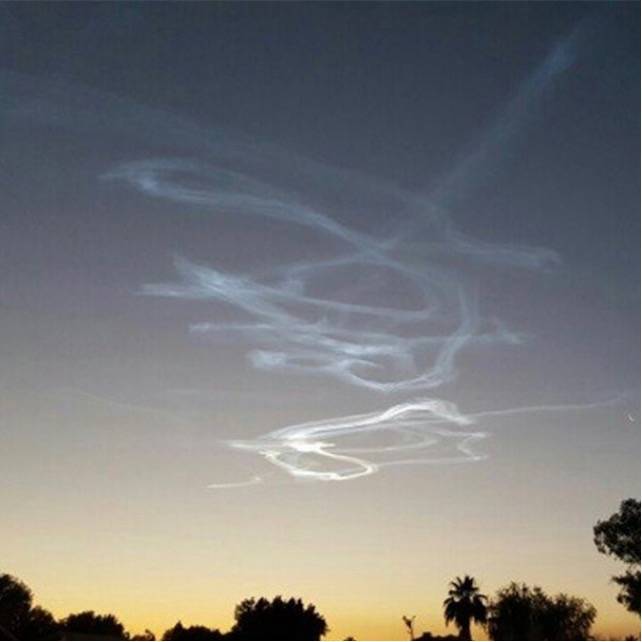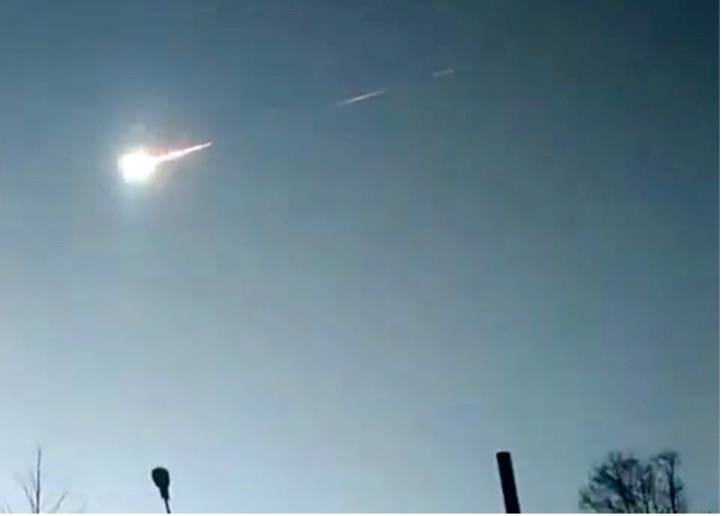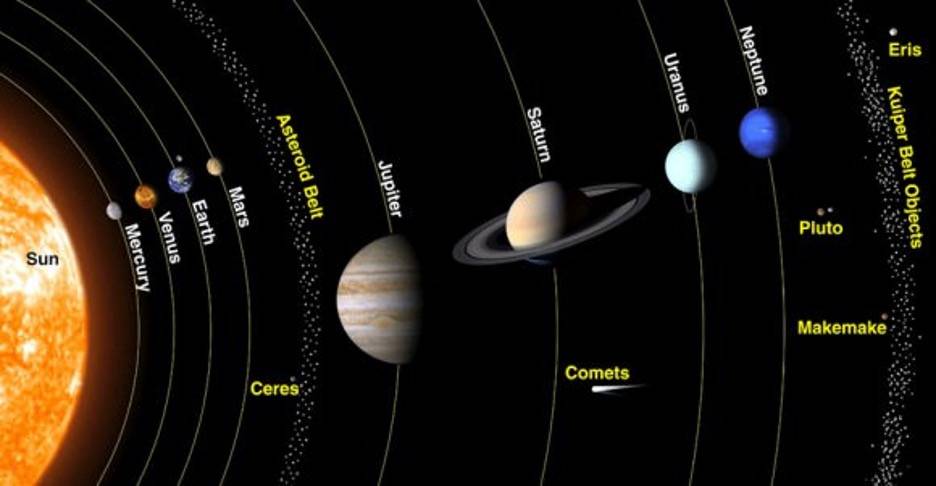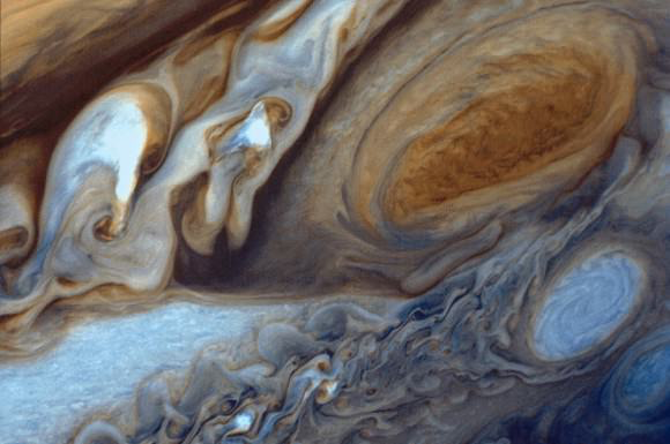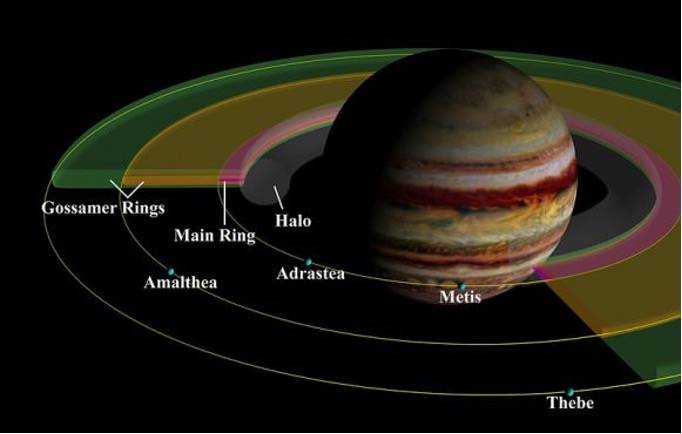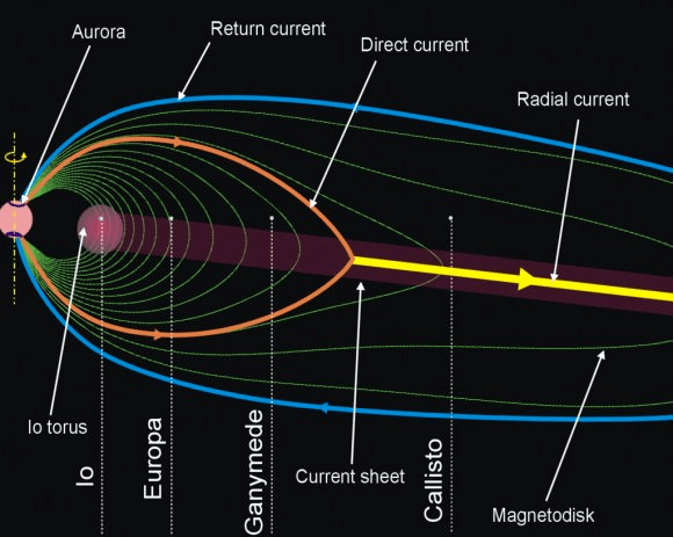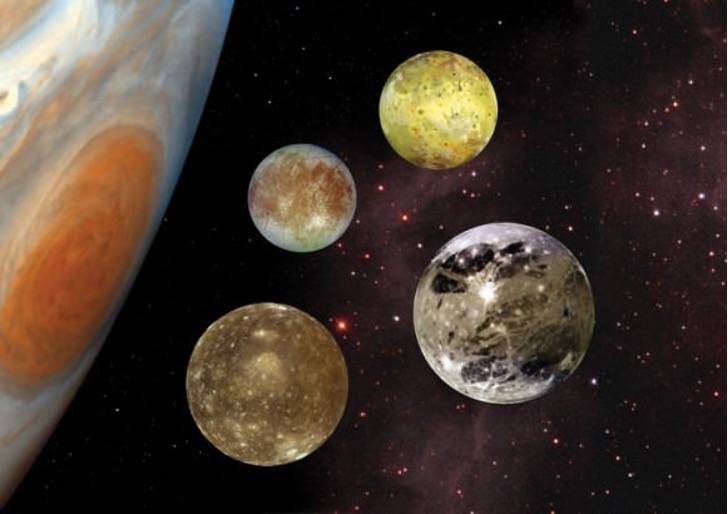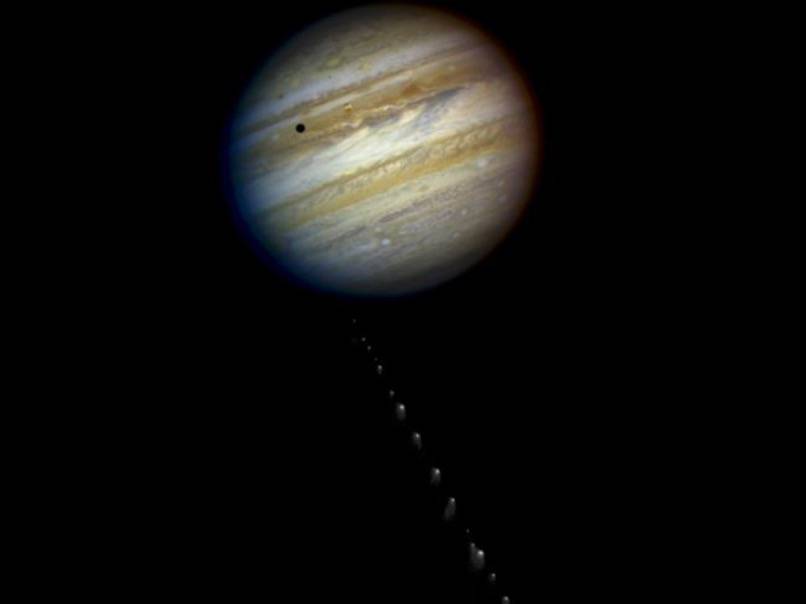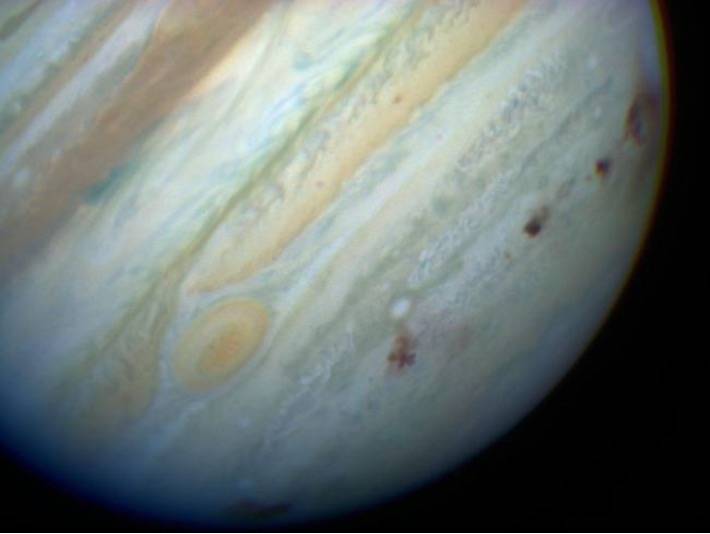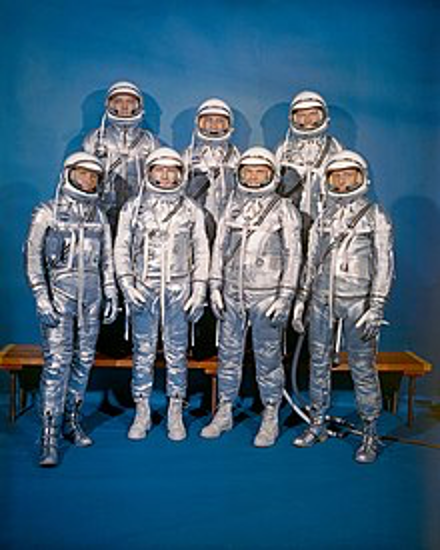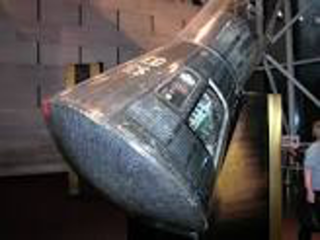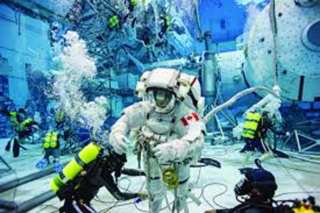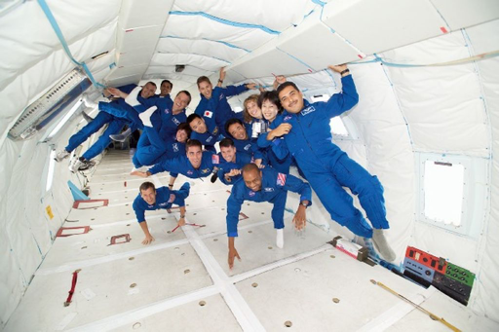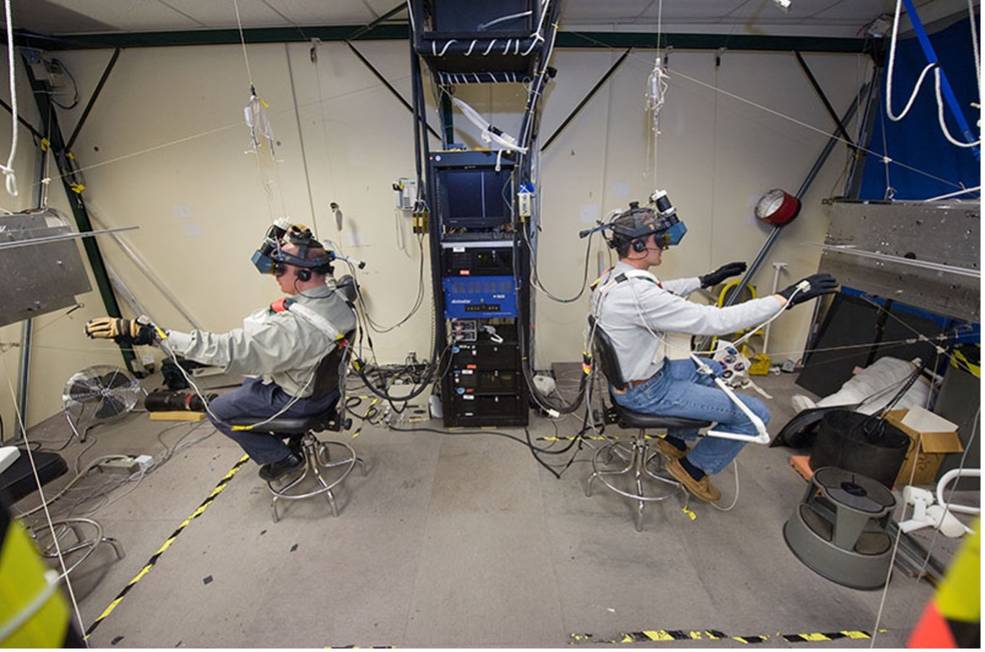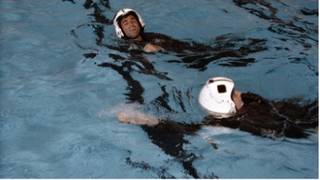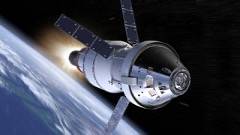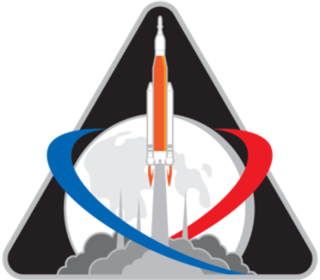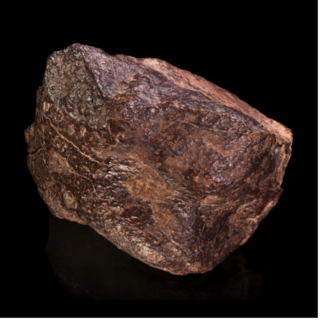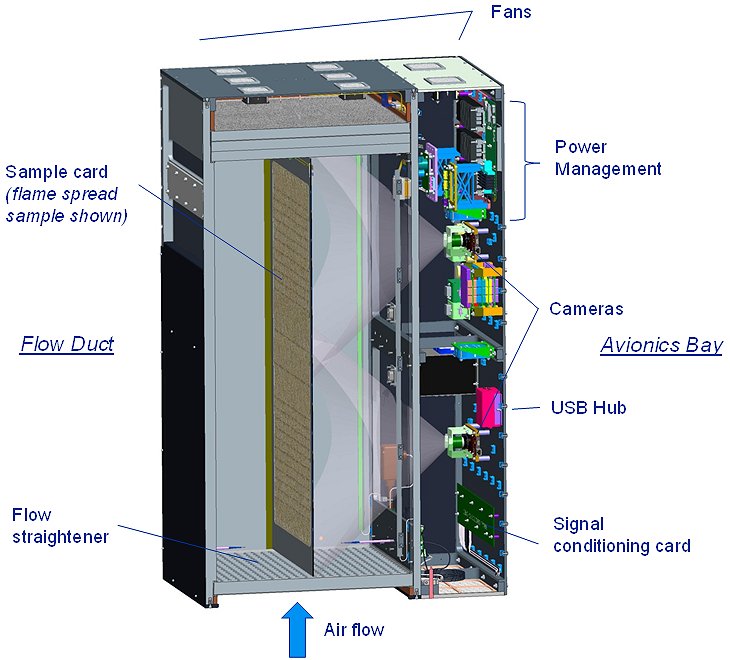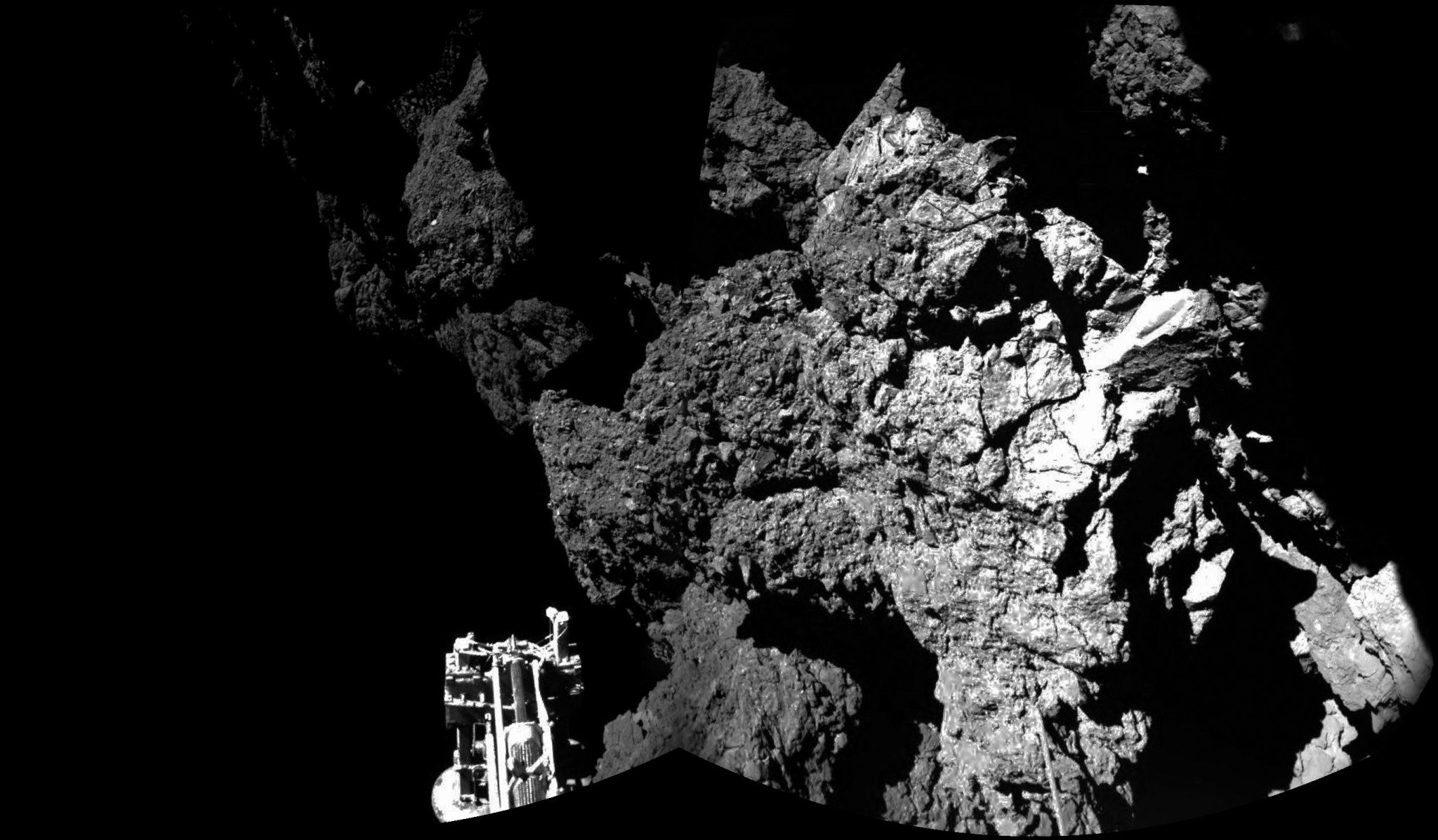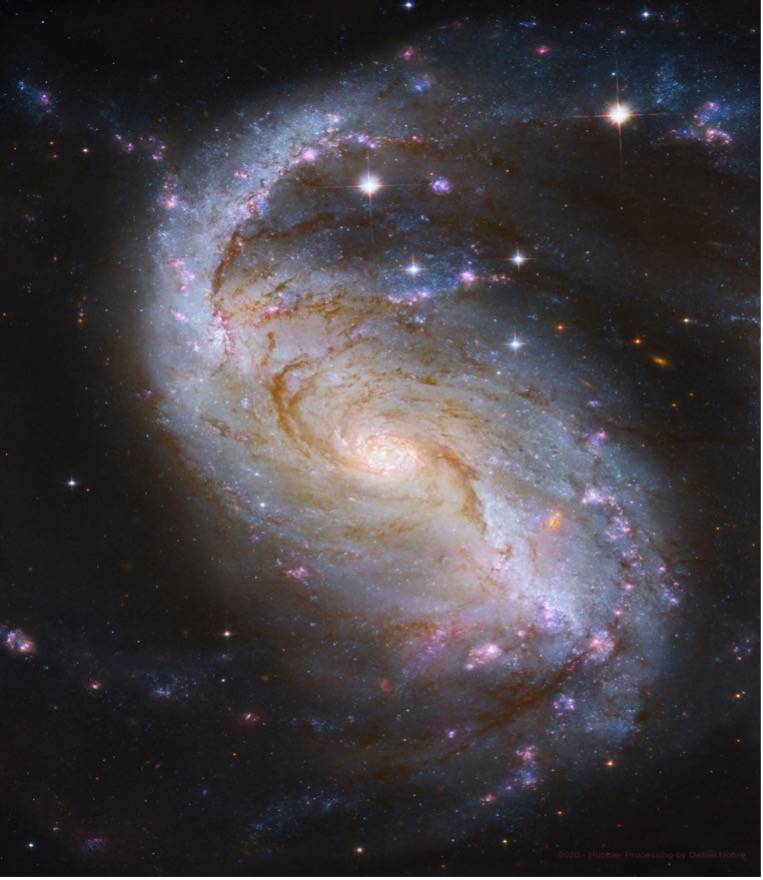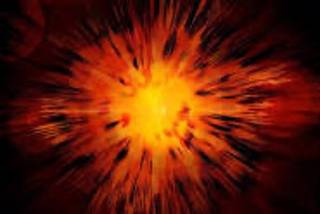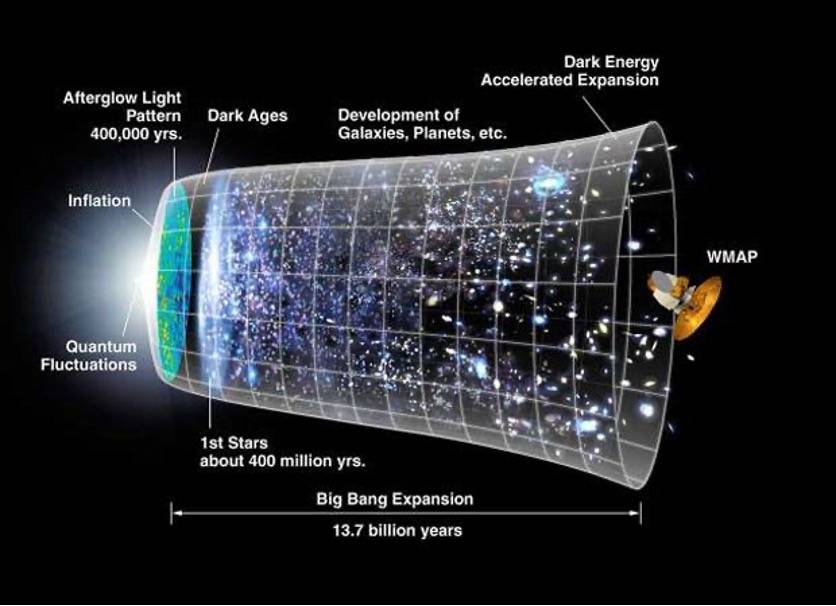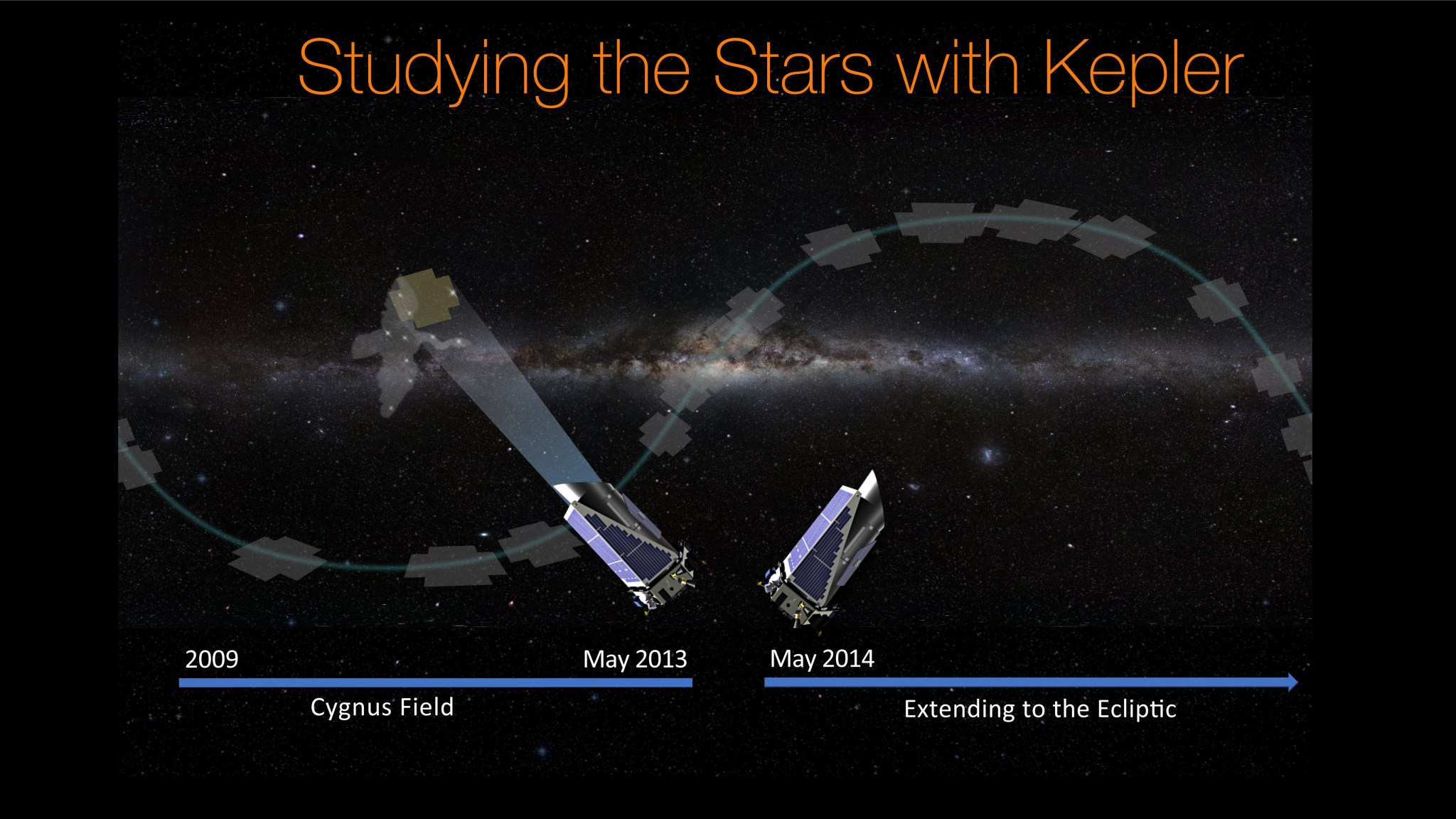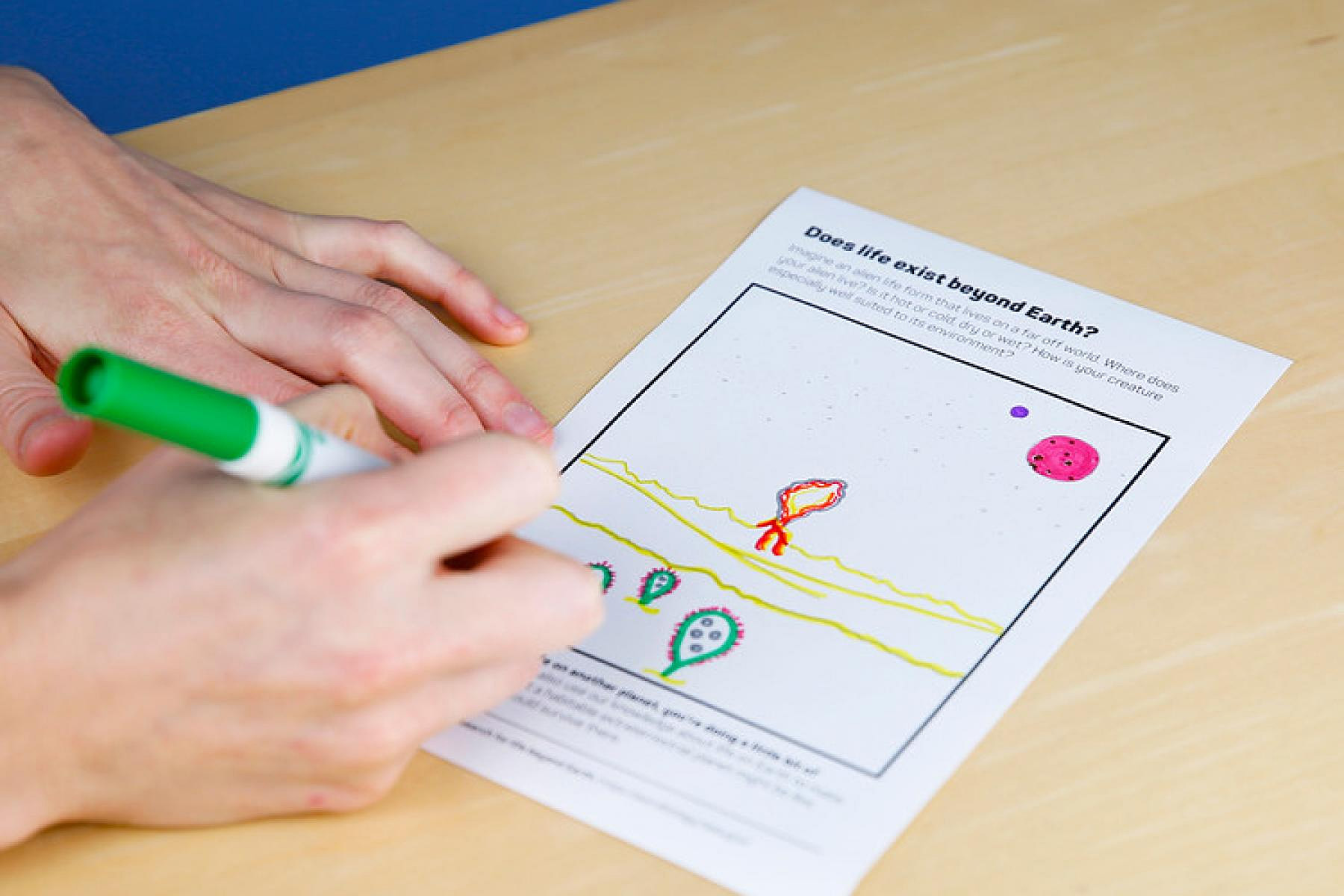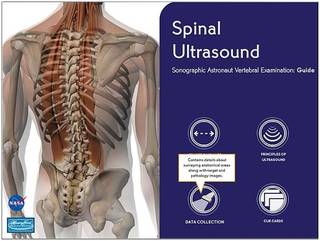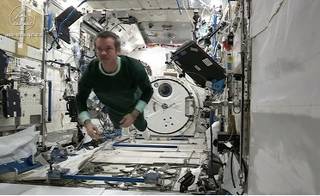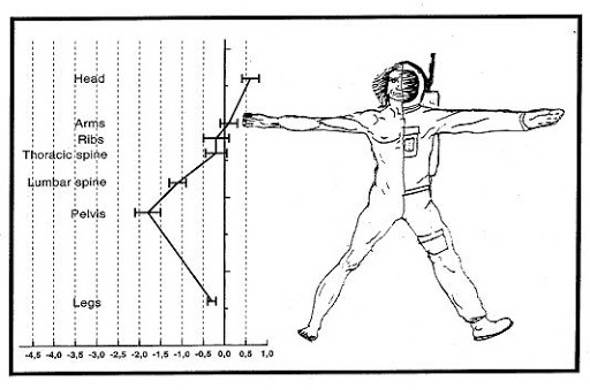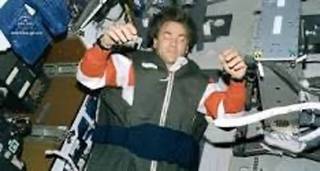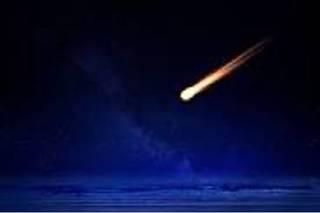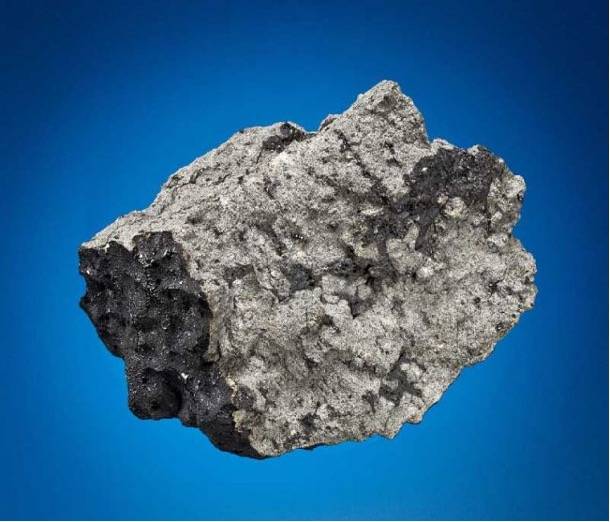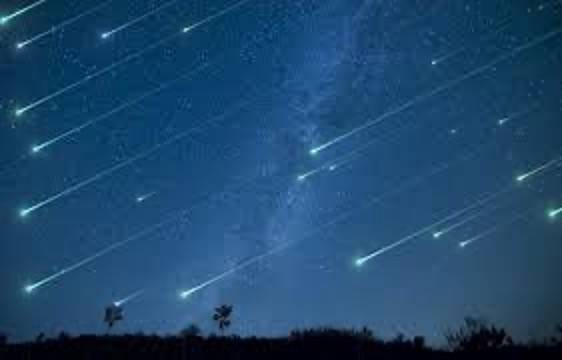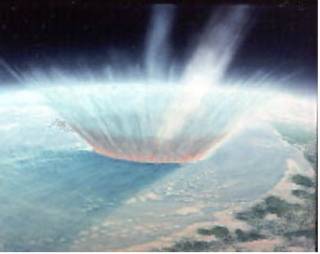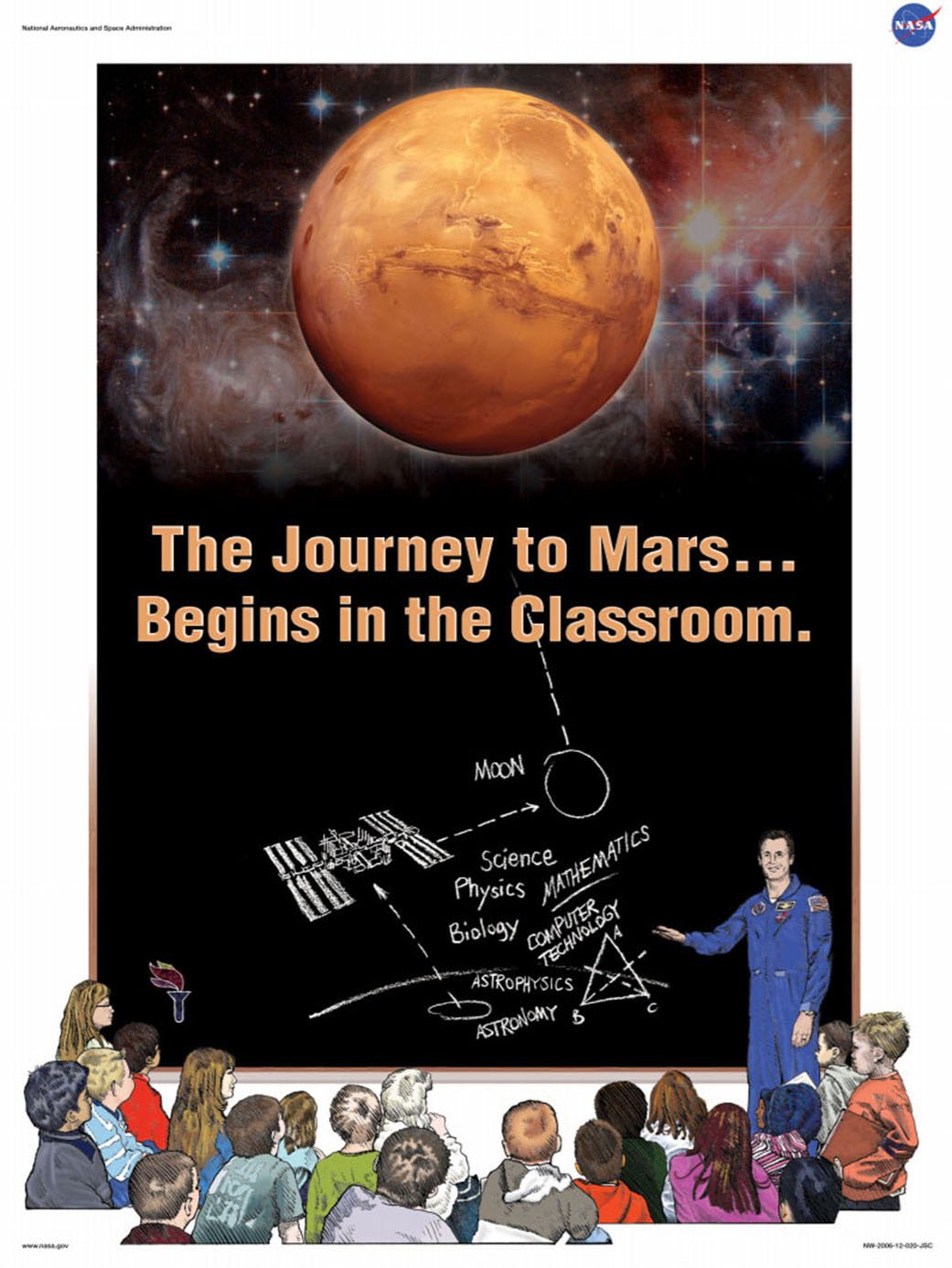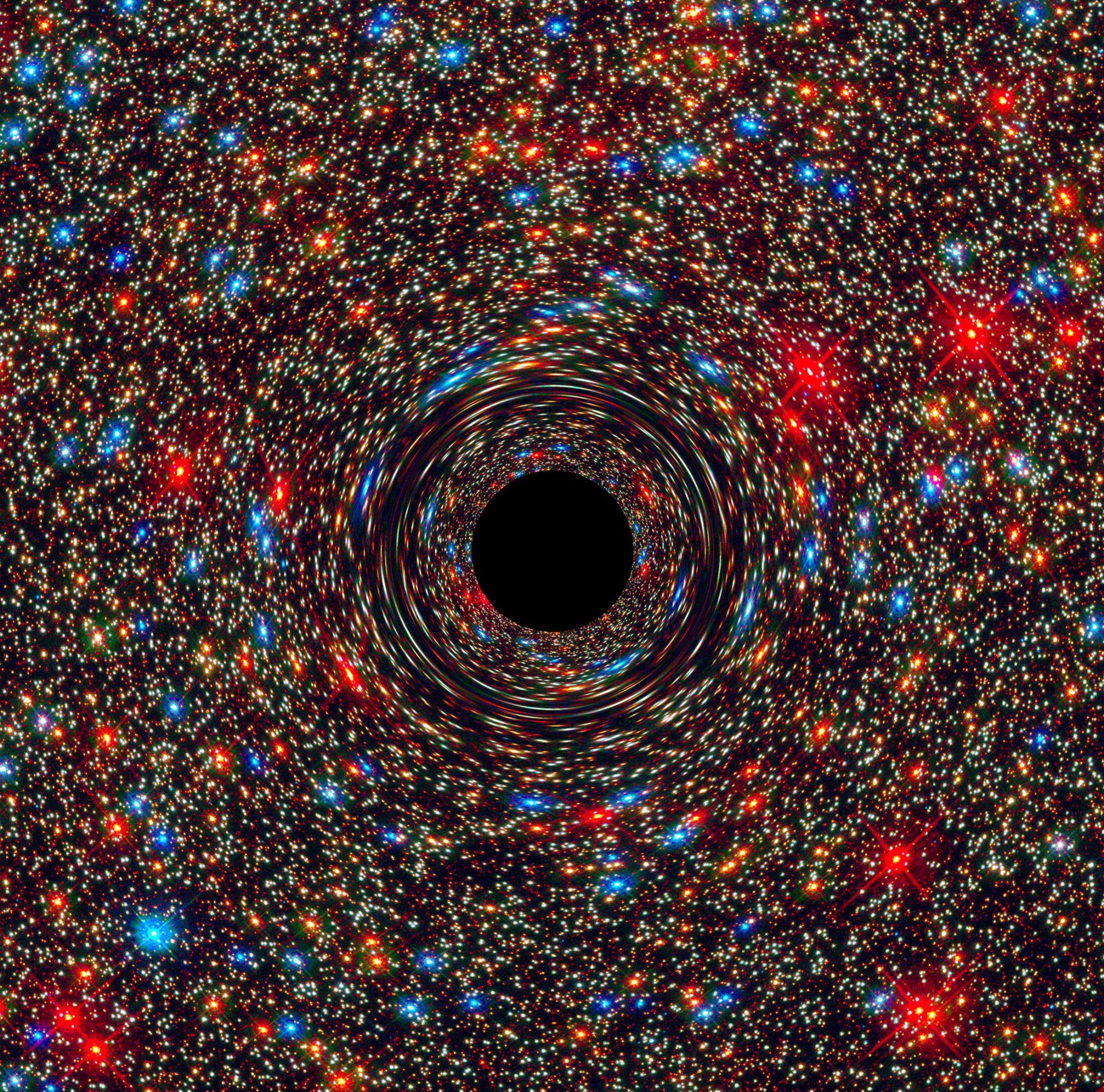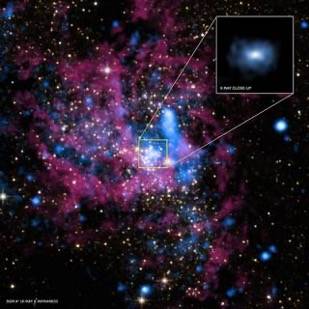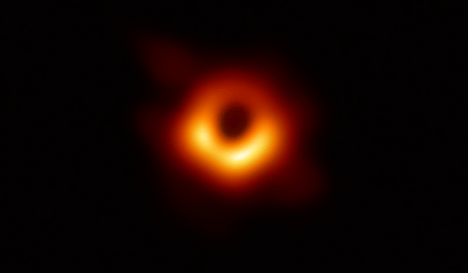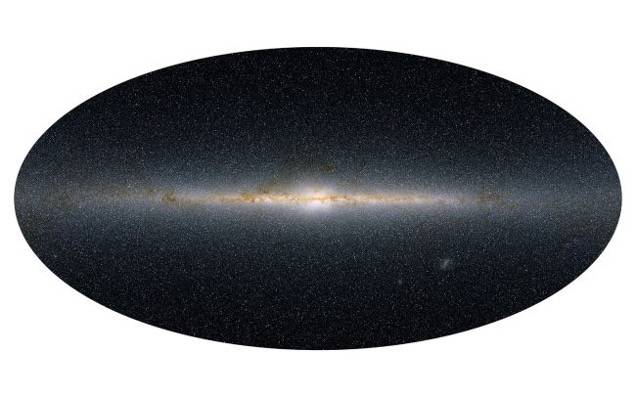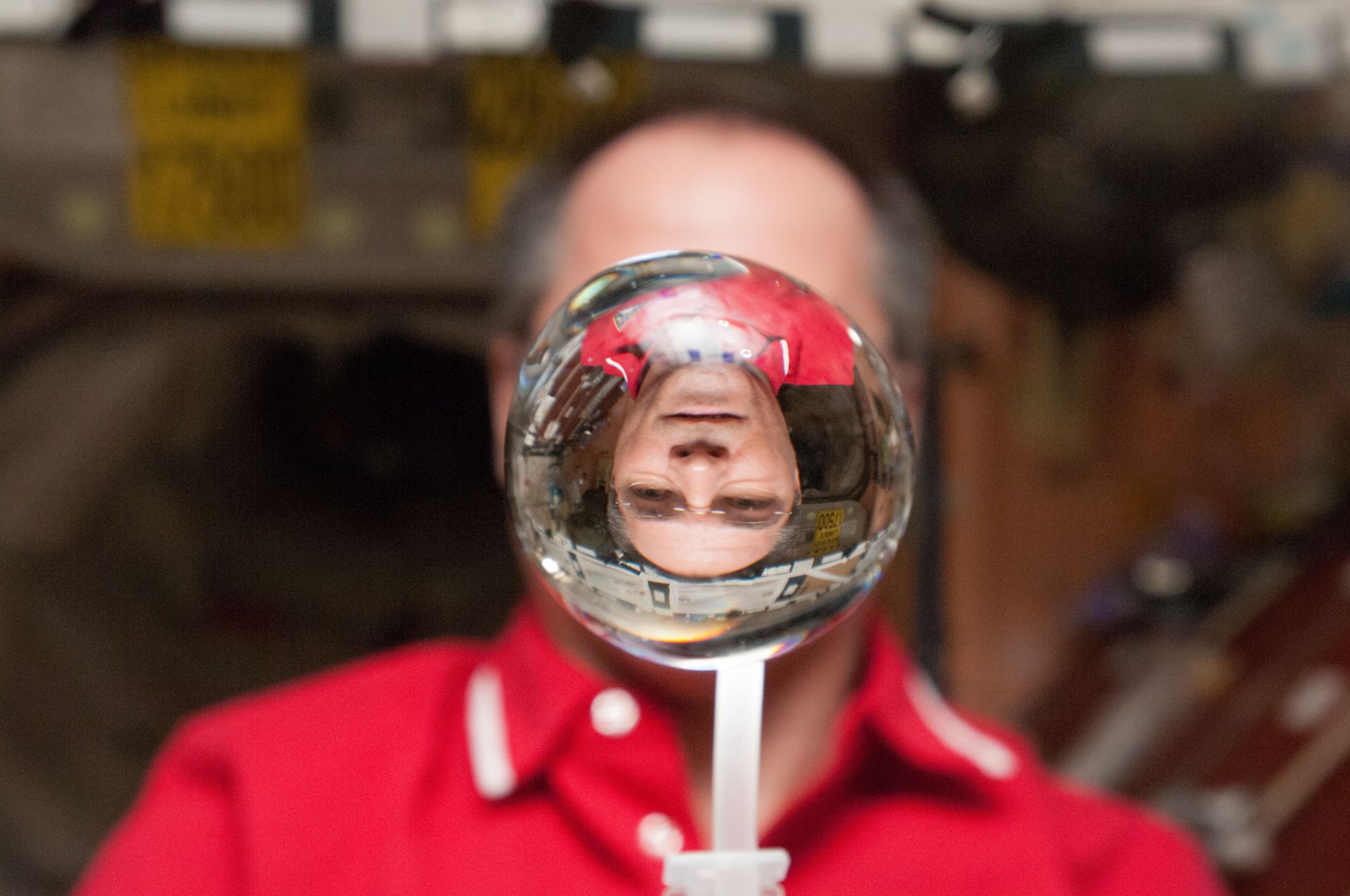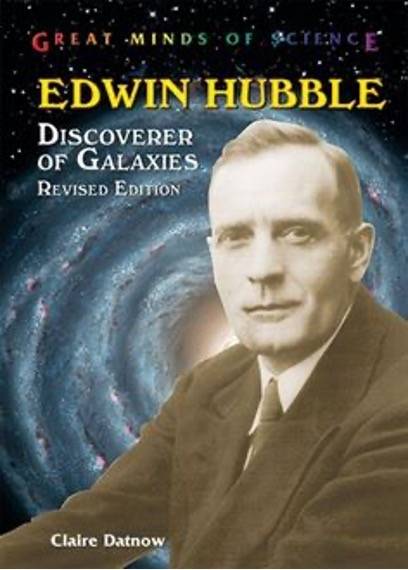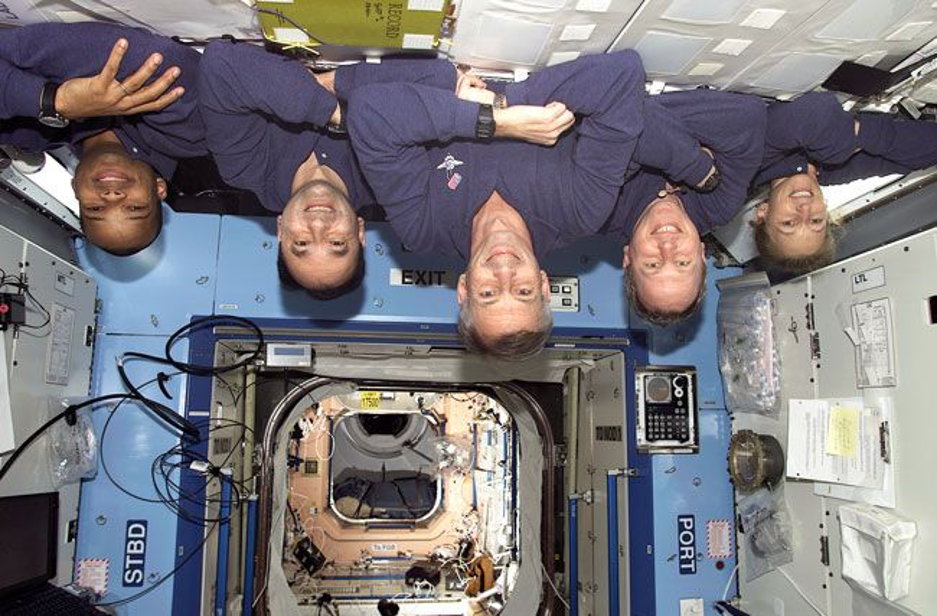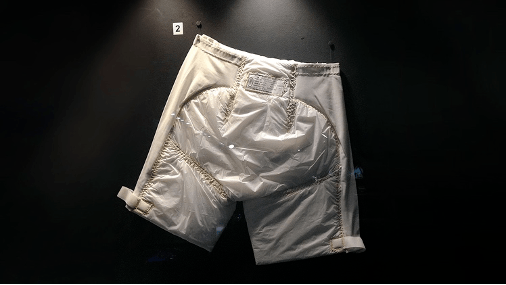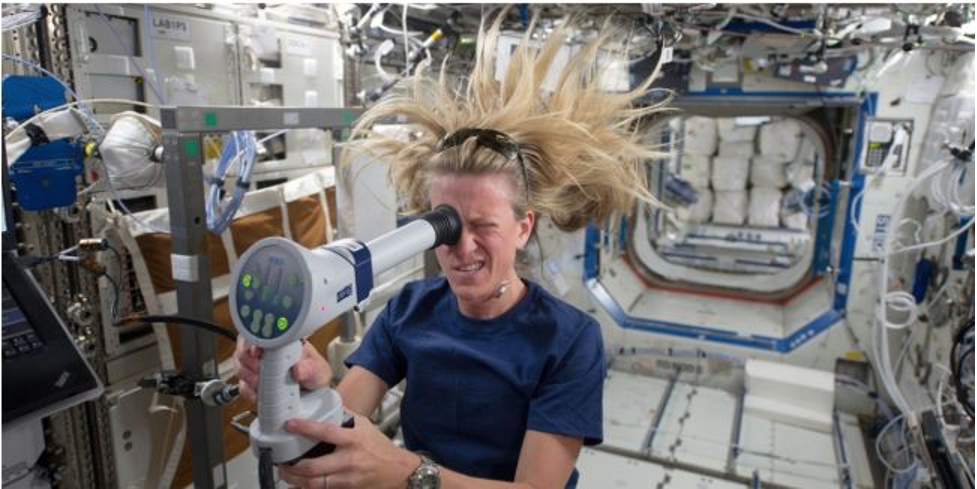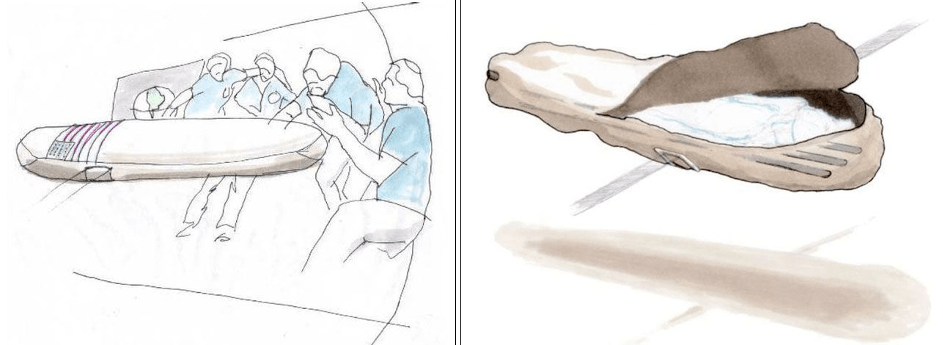December 2021: What does space smell like?
Ever wonder what outer space smells like? After coming back from a spacewalk and pulling off their helmets, astronauts are hit with the scent of cosmic molecules that hitch a ride on their suits. According to their descriptions, the smell is far from subtle. Former NASA astronaut, Greg Chamitoff, said, “there’s one smell up here that’s really unique though… we just call it the smell of space. There’s this really, really strong metallic smell and I don’t know exactly what it is.”
In the past, astronauts who have gone on spacewalks consistently speak of space’s extraordinarily peculiar odor. They can’t smell it while they’re actually bobbing in it, because the interiors of their spacesuits just smell plastic-y. But upon stepping back into the space station and removing their helmets, they get a strong, distinctive whiff of the final frontier. The odor clings to their suit, helmet, gloves and tools. Some have described it as akin to gunpowder or ozone.
Others liken it to “sweet-smelling welding fumes,”
“or seared steak,”
or other odd combos such as this description on Twitter from ESA astronaut, Alexander Gerst: “To me, space smells like a mixture between walnuts and the brake pads of my motorbike.”
The smell of space is so distinct that NASA reached out to Steven Pearce of the fragrance maker Omega Ingredients to re-create the odor for its training simulations. “Recently we did the smell of the moon,” Pearce says. “Astronauts compared it to spent gunpowder.”
“It’s like something I hadn’t ever smelled before, but I’ll never forget it,” NASA astronaut Kevin Ford said from orbit in 2009. After a 2003 mission, astronaut Don Pettit described it this way on a NASA blog:
“It is hard to describe this smell; it is definitely not the olfactory equivalent of describing the palette sensations of some new food that ‘tastes like chicken.’ The best description I can come up with is metallic; a rather pleasant sweet metallic sensation. It reminded me of my college summers where I labored for many hours with an arc welding torch repairing heavy equipment for a small logging outfit. It reminded me of pleasant sweet-smelling welding fumes. That is the smell of space.”
The interior of the International Space Station smells a little more mundane. Pettit, after returning from a second six-month-long mission on the ISS, told SPACE.com, “[The space station] smells like half machine-shop-engine-room-laboratory, and then when you’re cooking dinner and you rip open a pouch of stew or something, you can smell a little roast beef.”
But what exactly is causing this cocktail of unique aromas?
The short answer is we don’t know, but polycyclic aromatic hydrocarbons are likely contributors says Dr. Louis Allamandola, former director of the NASA Ames Astrophysics and Astrochemistry Laboratory. Polycyclic aromatic hydrocarbons are exceptionally robust, chicken wire-shaped molecules that are common throughout the universe. They are also common on Earth in things such as soot, car exhaust,
burnt toast,
and charred meat.
Elaborating, he continues “If we overlook the fact that space is an ultra-high vacuum and you couldn’t survive long enough to smell anything, what you’d ‘smell’ depends on where you are. There are two regions to think about. The first is the deep interstellar space between the stars that you see outside the dark lanes and blobs in the Milky Way on a clear and dark night. As stars come to the end of their life because they have exhausted the light elements like hydrogen and helium that fed their nuclear reactions, heavier elements like carbon, nitrogen and oxygen are formed and ejected. At this stage, some stars produce much more carbon than oxygen and form soot. Others produce much more oxygen than carbon and form silicates, the stuff of sand and rock. Some of these carbon-rich stars form so much soot it blocks the starlight from that star until the cloud clears out! The chemistry in these circumstellar shells is very, very similar to the combustion of fossil fuels. Just like a running car, if you starve it of oxygen you’ll start to see black soot from the exhaust and get a foul smell. Think about the black clouds coming out of trucks and buses using diesel fuels as they start from a stop. Also, think of burnt hamburgers and toast at BBQs and from recalcitrant toasters. Polycyclic aromatic hydrocarbons (PAHs), very complex molecules by interstellar standards, are key ingredients of soots. Since our noses are particularly sensitive to small PAHs, this is what you’d smell if you could inhale several hundred cubic miles of ‘space’. Because they are exceptionally stable, PAHs are pretty much the only molecules that can survive the harsh interstellar radiation fields and shock waves. Once formed at this stage in a star’s ‘life’, these carbon-rich soots and molecules are ejected into space where they float around for a VERY long time.”
“The second region is inside those dark lanes and blobs in the Milky Way. Eventually, enough of the soot and other dusty materials stars form at the end of their life collect in vast regions, forming the dark lanes and blobs which are called interstellar dust clouds. Even though there may be only one tiny dust grain in a region of space as big as a large auditorium, these dust clouds are so enormous that they block the light from the stars behind them. Here, the dust grains get very cold, some 15 degrees above absolute zero. In these clouds the atoms and molecules in the gases that float around freeze onto the grains forming new molecules. Even though they are so cold some chemistry happens, but in regions of the cloud where new stars and planets are forming, the UV is strong enough to drive chemistry in these very cold ices. As with the PAHs, these ices are similar no matter where we look. With some variation in concentrations, the recipe of these ices is mainly: water, alcohol, ammonia, and carbon dioxide, with lesser amounts of carbon monoxide, PAHs, formaldehyde, and even lesser amounts of molecules of great astrobiological interest. Here, the space in dark clouds would smell a bit like a crazy ice cream shop with the crisp touch of water ice dominated by a breathtaking, knee-buckling ammonia whiff; in some cases with an additional morgue-like accent due to the formaldehyde. Astrobiologically, the more complex molecules formed in lab simulations are similar to those that form cell membranes. Amino acids, nucleic acids, and sugars are also produced in the lab simulations. Since young planets and moons, as well as comets, form from these ices, these are important ingredients to early chemistry on young planets and moons.
Scott Sandford, Senior Research Scientist in the Ames Science Directorate offered these comments on the subject:
[Jupiter’s moon] Io is an environment that would likely have its own unique smell (I’m guessing strong overtones of rotten eggs).
A lot of what the space station astronauts smell is likely the result of a sort of combustion. The space station is at a low enough altitude that it is still plowing through a faint atmosphere that contains oxygen. The station rams through this residual atmosphere to create a halo of excited oxygen around the station and this results in oxidation of materials, particularly those facing the ram direction of the station. I observed this when I was a graduate student and we discovered that mylar films that faced forward were all ‘etched’ away.
Undoubtedly the same process is occurring to the astronauts’ suits. So… probably another example of a form of ‘combustion.’
So contrary to what you may have thought, if you have thought about this at all, the smells of space are many and varied. Deep space may have aromas reminiscent of a charcoal grill but once you get into dark clouds where stars and planets form, the smells can get even more interesting. In dark pockets of our galaxy and galaxies far, far away, molecular clouds full of tiny dust particles host a veritable smorgasbord of odors, from wafts of sweet sugar and rum to the rotten-egg stench of sulfur, and they float around for millions of years appearing in comets, meteors and space dust. These hydrocarbons have even been shortlisted for the basis of the earliest forms of life on Earth. Not surprisingly, polycyclic aromatic hydrocarbons can be found in coal, oil and even food.
However, these aromas are only some of the many odors that space could have. The universe is massive, after all, filled with many different elements and compounds. Scientists do have a pretty good idea of what a lot of “space stuff” is made of, giving them better ideas about what it might smell like. Memorably, the dust cloud at the center of the Milky Way contains large amounts of ethyl formate. This is the compound that, on Earth, gives raspberries their flavor. Yes, raspberries. What’s more, ethyl formate itself is created from a reaction between an acid and a type of alcohol, which gives it a smell similar to that of rum. Suddenly the smell of space—or at least that part of space—doesn’t seem so bad anymore!
Thanks and attribution:
Dr. Louis Allamandola, NASA Ames Research Center (ret.)
Dr. Scott Sandford, NASA Ames Research Center
Space Sights and Smells Surprise Rookie Astronauts
https://www.livescience.com/34085-space-smell.html
https://www.space.com/6509-space-smells-funny-astronauts.html
https://www.youtube.com/user/VideoFromSpace
See what the NASA Ames Laboratory Astrophysics and Astrochemistry groups have been up to here
November 2021: Space Biology
The main objective of Space Biology research is to build a better understanding of how spaceflight affects living systems in spacecraft such as the International Space Station (ISS), or in ground-based experiments, and to prepare for future human exploration missions far from Earth. The experiments conducted on these platforms examine how astronauts, plants, and animals regulate and sustain their growth in space. We examine processes of metabolism, reproduction, and development. We study how organisms repair cellular damage and protect themselves from infection and disease in conditions of microgravity. And we do it across the spectrum of biological organization, from molecules to cells, from tissues and organs, and from systems to whole organisms.
In addition to providing useful information on how living organisms adapt to spaceflight, the discoveries we make in space have enormous implications for life on Earth. Our research into the virulence of infections in space, bone density, and the growth of plants can impact the development of drugs that promote wound healing, treatments designed to counter osteoporosis on Earth, and high-tech fertilizers that increase crop yield.
The vast, cold, and radiation-filled conditions of outer space present an environmental challenge for any form of life. Earth’s biosphere has evolved for more than 3 billion years, shielded by the protective blanket of the atmosphere protecting terrestrial life from the hostile environment of outer space. Within the last 50 years, space technology has provided tools for transporting terrestrial life beyond this protective shield in order to study in situ responses to selected conditions of space. From a biological perspective applicable to organisms ranging from humans to microbes, the two most influential physical modifications experienced onboard an orbiting spacecraft are the state of near weightlessness created by the vehicle’s free-fall trajectory and the increased radiation exposure incurred as a consequence of being outside Earth’s protective atmosphere. Other environmental factors, such as space vacuum, thermal extremes, solar UV radiation, and the presence of high-velocity micrometeoroids and orbital debris, are mitigated by spacecraft design in order to provide internal conditions conducive to sustaining life. Alternatively, space technology provides the opportunity to expose microorganisms intentionally to the harsh external environment or selected parameters of it.
The simplest questions can be answered through experimentation. For example, over a year ago tiny green plants sprouted on the moon. The plants arrived as cotton seeds, tucked inside of Chang’e 4, a Chinese spacecraft that had landed, in a historic first, on the far side of the moon, the side that never turns toward Earth. The seeds came with the comforts of home: water, air, soil, and a heating system for warmth. Huddled together, the seedlings resembled a miniature, deep-green forest. A hint of life in a barren world.
And then, about a week later, they all died.
Lunar night had set in. Without ample sunlight, surface temperatures near the spacecraft plummeted to –52 degrees Celsius (–62 degrees Fahrenheit). The sprouts’ heating system wasn’t designed to last. The plants froze.
Outer space, as you might expect, is not kind to plants, or people, or most living things, except maybe for tardigrades, those microscopic creatures that look like little bears. If you stuck a daisy out of the International Space Station and exposed it to the vacuum of space, it would perish immediately. The water in its cells would rush out and dissipate as vapor, leaving behind a freeze-dried flower.
Read: A new clue in the search for forests on distant planets.
China’s experiment marked the first time biological matter has been grown on the moon. (There is biological matter on the moon already, in what NASA politely refers to as “defecation collection devices.”) But plants have blossomed in space for years. They just need a little more care and attention than their terrestrial peers.
Plants grow on the International Space Station, humankind’s sole laboratory above Earth. They are cultivated inside special chambers equipped with artificial lights pretending to be the sun. Seeds are planted in a nutrient-rich substance resembling cat litter and strewn with fertilizer pellets. Water, unable to flow on its own, is administered carefully and precisely to roots. In microgravity, gases sometimes coalesce into bubbles, and overhead, fans push the air around to keep the carbon dioxide and oxygen flowing.
The most advanced chamber on the station, about the size of a mini-fridge, has precise sensors monitoring the conditions inside, and all astronauts need to do is add water and change filters. Scientists back on the ground can control everything, from the temperature and humidity to levels of oxygen and carbon dioxide.
Plants did not evolve to exist in this unusual setup. But astronauts have grown several varieties of lettuce, radishes, peas, zinnias, and sunflowers, and they do just fine. “Plants are very adaptive, and they have to be—they can’t run away,” says Gioia Massa, a scientist at NASA’s Kennedy Space Center who studies plants in microgravity.
Scientists were surprised to learn that the lack of gravity, the force that has shaped our biological processes, doesn’t derail plants’ development. On Earth, plants produce a filigree-like pattern of roots, as they grow away from their seeds in search of nutrients. Scientists had long assumed the movements were influenced, in part, by the force of gravity. On the International Space Station, roots exhibited the same pattern, without gravity as a guide.
“Plants don’t really care about the gravity so much if you can get the environment right,” Massa says.
For NASA, plant growth chambers on the space station are the predecessors of extraterrestrial farms beyond Earth. If human beings ever travel to another planet, they will need enough food for the journey. NASA has spent years perfecting thermo-stabilized or freeze-dried entrées and snacks for astronauts on the International Space Station, from scrambled eggs to chicken teriyaki. The meals are meant to last, but they wouldn’t survive the long journey to Mars, says Julie Robinson, the chief scientist for the International Space Station.
Plants, Muscles, Microbes and Cells: NASA Biology Experiments Are Space Station-Bound
Several bioscience experiments developed at NASA’s Ames Research Center, in California’s Silicon Valley launched to the International Space Station on SpaceX’s 13th commercial resupply services mission for NASA.
This resupply mission from Cape Canaveral Air Force Station in Florida carried experiments investigating muscle wasting, plant growth in low gravity, and the microorganisms inhabiting the space station. A new research facility that may help scientists better understand how key spaceflight factors, such as microgravity and space radiation, can affect human health during long exploration voyages, and reveal some of the fundamental workings of life here on Earth, is also packed in the Dragon capsule.
These are four seemingly distinct experiments, but all with the common goal of moving humans farther into the solar system than we’ve ever been before.
A Brand-New Tool for Biology in Space – The Bioculture System
Life functions differently in space, and biologists can learn a lot about how this impacts human health by studying cells grown in the microgravity environment, or “weightlessness,” of the International Space Station. The Bioculture System is a new research facility for the orbiting laboratory that will let scientists carry out long-term cell biology studies, on a broad range of subjects and diverse cell and tissue types. This new hardware will allow for real-time remote monitoring of cell cultures, and finer control over the conditions in which they grow.
The first mission to use it, called Cell Science Validation, will fully test the system’s complex engineering and life support capabilities, to make sure it can function properly in microgravity and successfully grow a variety of cells, like bone and heart cells in this experiment, on the space station. Once the initial validation is complete, the facility will be available for use by the broad scientific community for exciting, new advanced research, from fundamental cell biology, to drug discovery, microbiology, and tissue engineering.
A New Device to Fight Muscle Loss – Rodent Research-6
Muscle wasting is a common problem for patients experiencing prolonged immobilization, injuries, cancer or aging. Muscle atrophy happens to astronauts in microgravity too. The Rodent Research-6 study will evaluate a new drug delivery device for administering continuous, low doses, which could help counteract muscle wasting and prevent the need for daily or frequent drug administration. A tiny capsule, implanted under the skin, delivers a constant, low dose of the drug via a silicone membrane, with channels as narrow as 1/50,000 the width of a human hair. The low-dose delivery could also help avoid the known side effects of taking high doses over the long term. The drug, called formoterol, is a common therapy in asthma inhalers and for other lung diseases. It relaxes muscles responsible for tightening a patient’s airways. Rodent Research-6 will look at how effectively it can counteract muscle wasting when released by a tiny, but potentially powerful device.
Finding out How Plants Sense Gravity – Plant Gravity Perception
We tend to take gravity for granted, but plants never do. They respond constantly to the pull of gravity, using it to send shoots up and roots down, and to determine their overall shape. The Plant Gravity Perception mission aims to discover the lowest level of gravity that a plant seedling is able to perceive. Working in the microgravity environment of the space station, the experiment will use a centrifuge system to simulate a range of gravity levels. Video data of the plants’ responses will be captured, helping to reveal if there is a threshold level they need to sense gravity, respond, and thrive. Understanding how this works could help researchers develop plants that are well adapted for growth on long-duration space missions, or to be hardier for agricultural purposes on Earth.
Tracking Microbes on the Space Station – Microbial Tracking-2
Microbial Tracking-2 is an experiment spanning many months that is tracking the populations of microbes sharing the International Space Station with the astronauts. These are the same types of microorganisms we have on Earth, which would have arrived initially on cargo resupplying the space station or on astronauts during crew changes. In order to catalog and characterize potential disease-causing microbes aboard the space station, researchers first have to know what kind of microorganisms may already be on station. Samples are collected from the astronauts’ bodies before, during and after flight. Environmental samples are also taken from surface and air locations around the station. The samples are analyzed to identify the types of microbes potentially found, and to see if there are types that could affect human health. Interactions among the microbes are studied, as well as the development of microbial communities.
Several SpaceX resupply missions have already delivered kits for microbial sampling and brought earlier samples back to Earth to be analyzed by scientists. By taking multiple samples across time, researchers are able to see how the microbial population is changing on the space station. The findings from this research may help determine how microorganisms affect both the crew’s health and the performance of the spacecraft. With this knowledge, NASA can develop ways of minimizing the impact from microorganisms during long-duration space missions with human explorers.
Thanks and attribution:
https://mmbr.asm.org/content/74/1/121
October 2021: Fireballs
A recent post on meteors prompts this related one about fireballs. What in the world is a fireball? According to the American Meteor Society, a fireball is another term for a very bright meteor, generally brighter than magnitude -4, which is about the same magnitude of the planet Venus in the morning or evening sky. What makes them significant is that they are bright enough to be visible in the daytime, although they also occur at night, depending on the point of view of the observer on earth. A special category of fireball is the bolide, which is an extremely bright meteor, especially one that explodes in the atmosphere.
Several thousand meteors of fireball magnitude occur in the Earth’s atmosphere each day. The vast majority of these, however, occur over the oceans and uninhabited regions, and a good many are masked by daylight. Those that occur at night also stand little chance of being detected due to the relatively low numbers of persons out to notice them.
Additionally, fireballs and bolides can be detected by space-based detectors designed for other purposes. The Geostationary Lightning Mapper (GLM) instruments on the GOES weather satellites can detect fireballs and bolides. Details about events detected since 2019. Other US Government sensors also detect fireballs; here is a map that shows where to find them.
The brighter the fireball, the rarer is the event. As a general rule of thumb, there are only about 1/3 as many fireballs present for each successively brighter magnitude class, following an exponential decrease. Experienced observers can expect to see only about 1 fireball of magnitude -6 or better for every 200 hours of meteor observing, while a fireball of magnitude -4 can be expected about once every 20 hours or so.
This is a fascinating list of FAQ’s about fireballs from the American Meteor Society website.
Can you see fireballs in daylight, and will a fireball leave a trail?
Yes, but the meteor must be brighter than about magnitude -6 to be noticed in a portion of the sky away from the sun and must be even brighter when it occurs closer to the sun.
Fireballs can develop two types of trails behind them: trains and smoke trails. A train is a glowing trail of ionized and excited air molecules left behind after the passage of the meteor. Most trains last only a few seconds, but on rare occasions, a train may last up to several minutes. A train of this duration can often be seen to change shape over time as it is blown by upper atmospheric winds. Trains generally occur very high in the meteoric region of the atmosphere, generally greater than 80 km (65 miles) altitude, and are most often associated with fast meteors. Fireball trains are often visible at night, and very rarely by day.
The second type of trail is called a smoke trail and is more often seen in daylight fireballs than at night. Generally occurring below 80 km of altitude, smoke trails are a non-luminous trail of particulate stripped away during the ablation process. These appear similar to contrails left behind by aircraft and can have either a light or dark appearance.
The Great Daylight Fireball was an Earth-grazing fireball that passed within 57 kilometers (35 mi; 187,000 ft) of Earth’s surface at 20:29 UTC on August 10, 1972. It entered Earth’s atmosphere at a speed of 15 kilometers per second in daylight over Utah, United States (14:30 local time) and passed northwards leaving the atmosphere over Alberta, Canada. It was seen by many people and recorded on film and by space-borne sensors. An eyewitness to the event, located in Missoula, Montana, saw the object pass directly overhead and heard a double sonic boom. As a university student in Utah at the time, I actually saw this fireball for about 15 seconds as it passed overhead on a trajectory towards the northeast, approximately from the perspective of this video:
Vivid colors are more often reported by fireball observers because the brightness is great enough to fall well within the range of human color vision. These must be treated with some caution, however, because of well-known effects associated with the persistence of vision. Reported colors range across the spectrum, from red to bright blue, and (rarely) violet. The dominant composition of a meteoroid can play an important part in the observed colors of a fireball, with certain elements displaying signature colors when vaporized. For example, sodium produces a bright yellow color, nickel shows as green, and magnesium as blue-white. The velocity of the meteor also plays an important role, since a higher level of kinetic energy will intensify certain colors compared to others. Among fainter objects, it seems to be reported that slow meteors are red or orange, while fast meteors frequently have a blue color, but for fireballs, the situation seems more complex than that, but perhaps only because of the curiosities of color vision mentioned above.
The difficulties of specifying meteor color arise because meteor light is dominated by emission, rather than a continuous, spectrum. The majority of light from a fireball radiates from a compact cloud of material immediately surrounding the meteoroid or closely trailing it. 95% of this cloud consists of atoms from the surrounding atmosphere; the balance consists of atoms of vaporized elements from the meteoroid itself. These excited particles will emit light at wavelengths characteristic for each element. The most common emission lines observed in the visual portion of the spectrum from ablated material in the fireball head originate from iron (Fe), magnesium (Mg), and sodium (Na). Silicon (Si) may be under-represented due to the incomplete dissociation of SiO2 molecules. Manganese (Mn), Chromium (Cr), Copper (Cu) have been observed in fireball spectra, along with rarer elements. The refractory elements Aluminum (Al), Calcium (Ca), and Titanium (Ti) tend to be incompletely vaporized and thus also under-represented in fireball spectra.
Can a fireball create a sound? Will the sound occur right away, as you watch the fireball, or is there some delay?
There are two reported types of sounds generated by very bright fireballs, both of which are quite rare. These are sonic booms and electrophonic sounds. If a very bright fireball, usually greater than magnitude -8, penetrates to the stratosphere, below an altitude of about 50 km (30 miles), and explodes as a bolide, there is a chance that sonic booms may be heard on the ground below. This is more likely if the bolide occurs at an altitude angle of about 45 degrees or so for the observer, and is less likely if the bolide occurs overhead (although still possible) or near the horizon. Because sound travels quite slowly, at only about 20 km per minute, it will generally be 1.5 to 4 minutes after the visual explosion before any sonic boom can be heard. Observers who witness such spectacular events are encouraged to listen for a full 5 minutes after the fireball for potential sonic booms.
Another form of sound frequently reported with bright fireballs is the “electrophonic” sound, which occurs coincidentally with the visible fireball. The reported sounds range from hissing static to sizzling, to popping sounds. Often, the witness of such sounds is located near some metal object when the fireball occurs. Additionally, those with a large amount of hair seem to have a better chance of hearing these sounds. Electrophonic sounds have never been validated scientifically, and their origin is unknown. Currently, the most popular theory is the potential emission of VLF radio waves by the fireball, although this has yet to be verified.
How bright does a meteor have to be before there is a chance of it reaching the ground as a meteorite?
Generally speaking, a fireball must be greater than about magnitude -8 to -10 in order to potentially produce a meteorite fall. Two important additional requirements are that (1) the parent meteoroid must be of asteroidal origin, composed of sufficiently sturdy material for the trip through the atmosphere, and (2) the meteoroid must enter the atmosphere as a relatively slow meteor. Meteoroids of asteroid origin make up only a small percentage (about 5%) of the overall meteoroid population, which is primarily cometary in nature.
Photographic fireball studies have indicated that a fireball must usually still be generating visible light below the 20 km (12 miles) altitude level in order to have a good probability of producing a meteorite fall. Very bright meteors of magnitude -15 or better have been studied which produced no potential meteorites, especially those having a cometary origin.
Can a meteorite dropping fireball be observed all the way to impact the ground?
No. At some point, usually between 15 to 20 km (9-12 miles or 48,000-63,000 feet) altitude, the meteoroid remnants will decelerate to the point that the ablation process stops, and visible light is no longer generated. This occurs at a speed of about 2-4 km/sec (4500-9000 mph).
From that point onward, the stones will rapidly decelerate further until they are falling at their terminal velocity, which will generally be somewhere between 0.1 and 0.2 km/sec (200 mph to 400 mph). Moving at these rapid speeds, the meteorite(s) will be essentially invisible during this final “dark flight” portion of their fall.
Meteor fireball lights up the night sky in Perth, Australia
Are meteorites “glowing” hot when they reach the ground?
Probably not. The ablation process, which occurs over the majority of the meteorite’s path, is a very efficient heat removal method and was effectively copied for use during the early manned space flights for re-entry into the atmosphere. During the final free-fall portion of their flight, meteorites undergo very little frictional heating and probably reach the ground at only slightly above ambient temperature. For the obvious reason, however, exact data on meteorite impact temperatures is rather scarce and prone to hearsay. Therefore, we are only able to give you an educated guess based upon our current knowledge of these events.
How frequently do meteorite falls occur?
The best estimates of the total incoming meteoroid flux indicate that about 10 to 50 meteorite dropping events occur over the earth each day. It should be remembered, however, that 2/3 of these events will occur over the ocean, while another 1/4 or so will occur over very uninhabited land areas, leaving only about 2 to 12 events each day with the potential for discovery by people. Half of these again occur on the night side of the earth, with even less chance of being noticed. Due to the combination of all of these factors, only a handful of witnessed meteorite falls occur Each year. As an order of magnitude estimation, each square kilometer of the earth’s surface should collect 1 meteorite fall about once every 50,000 years, on average. If this area is increased to 1 square mile, this time period becomes about 20,000 years between falls.
How fast are meteorites traveling when they reach the ground?
Meteoroids enter the earth’s atmosphere at very high speeds, ranging from 11 km/sec to 72 km/sec (25,000 mph to 160,000 mph). However, similar to firing a bullet into water, the meteoroid will rapidly decelerate as it penetrates into increasingly denser portions of the atmosphere. This is especially true in the lower layers since 90 % of the earth’s atmospheric mass lies below 12 km (7 miles / 39,000 ft) of height.
At the same time, the meteoroid will also rapidly lose mass due to ablation. In this process, the outer layer of the meteoroid is continuously vaporized and stripped away due to high-speed collision with air molecules. Particles from dust size to a few kilograms mass are usually completely consumed in the atmosphere.
Due to atmospheric drag, most meteorites, ranging from a few kilograms up to about 8 tons (7,000 kg), will lose all of their cosmic velocity while still several miles up. At that point, called the retardation point, the meteorite begins to accelerate again, under the influence of the Earth’s gravity, at the familiar 9.8 meters per second squared. The meteorite then quickly reaches its terminal velocity of 200 to 400 miles per hour (90 to 180 meters per second). The terminal velocity occurs at the point where the acceleration due to gravity is exactly offset by the deceleration due to atmospheric drag.
Meteoroids of more than about 10 tons (9,000 kg) will retain a portion of their original speed, or cosmic velocity, all the way to the surface. A 10-ton meteoroid entering the Earth’s atmosphere perpendicular to the surface will retain about 6% of its cosmic velocity on arrival at the surface. For example, if the meteoroid started at 25 miles per second (40 km/s) it would (if it survived its atmospheric passage intact) arrive at the surface still moving at 1.5 miles per second (2.4 km/s), packing (after considerable mass loss due to ablation) some 13 gigajoules of kinetic energy.
On the very large end of the scale, a meteoroid of 1,000 tons (9 x 10^5 kg) would retain about 70% of its cosmic velocity, and bodies of over 100,000 tons or so will cut through the atmosphere as if it were not even there. Luckily, such events are extraordinarily rare.
All this speed in atmospheric flight puts great pressure on the body of a meteoroid. Larger meteoroids, particularly the stone variety, tend to break up between 7 and 17 miles (11 to 27 km) above the surface due to the forces induced by atmospheric drag, and perhaps also due to thermal stress. A meteoroid which disintegrates tends to immediately lose the balance of its cosmic velocity because of the lessened momentum of the remaining fragments. The fragments then fall on ballistic paths, arcing steeply toward the earth. The fragments will strike the earth in a roughly elliptical pattern (called a distribution, or dispersion ellipse) a few miles long, with the major axis of the ellipse being oriented in the same direction as the original track of the meteoroid. The larger fragments, because of their greater momentum, tend to impact further down the ellipse than the smaller ones. These types of falls account for the “showers of stones” that have been occasionally recorded in history. Additionally, if one meteorite is found in a particular area, the chances are favorable for there being others as well.
What do fireballs and meteorites tell us about their origins?
Most of our current knowledge about the origin of meteoroids comes from photographic fireball studies (meteors > magnitude -4) done over the last 50 years or so. This may sound like a long time, but good data has been collected on only about 800 fireballs so far. Of these, only 4 have been recovered on the ground as meteorites. A meteorite-causing fireball is very rare and must be at least magnitude -8 to have sufficient mass to survive the trip. Even with an accurate photographic or video trajectory, it is still a matter of finding a needle in a haystack once the meteorite is on the ground. In recorded scientific history, unphotographed (eye-witnessed) falls have resulted in only about 900 meteorite finds.
Fireball Population:
When only the population of meteors of > -4 magnitude are considered, the more sturdy asteroidal meteoroids begin to make up an increasingly higher percentage when compared to fainter magnitudes. There are four basic fireball classes which are divided as follows:
- Cometary meteoroids: 38%
- Type IIIa fireballs, high-density comets: 29%
- Type IIIb fireballs, low-density comets: 9%
- Chondritic meteoroids: 62%
- Type II fireballs, Carbonaceous Chondrites: 33%
- Type I fireballs, Ordinary chondrites: 29%
- Non-chondritic meteoroids: <1%
- No fireball class
Thanks and attribution:
https://www.facebook.com/graeme.whipps.photography/
https://petapixel.com/2019/01/04/this-photo-shows-the-rainbow-colors-of-a-geminid-meteor/
September 2021: Interesting Facts about Jupiter
Jupiter is the largest planet in our solar system and it has been the focus of interest ever since it was independently discovered by Galileo Galilei and Simon Marius in 1610. Discovery isn’t the correct word, but Galileo and Simon were the first astronomers to detail extensive observations about the planet. They both observed the four largest moons that orbit the planet. These moons are:
- Io
- Europa
- Ganymede
- Callisto
Galileo began seriously observing the planet in 1609. This discovery of Jupiter’s moons occurred on January 7, 1610. Galileo wrote that there were “three fixed stars, totally invisible by their smallness” that were extremely close to Jupiter. However, when Galileo observed them on a different night, the “fixed stars” had changed positions. Galileo soon realized that the fixed stars were actually orbiting Jupiter. On January 10, 1610, Galileo discovered another one of Jupiter’s moons.
Galileo continued to observe the moons for over a year. He attempted to estimate their periods. Impressively, Galileo’s estimations were quite close to the actual periods of the moons.
Here are a few more interesting facts about Jupiter.
1. Jupiter is massive.
Jupiter is the largest planet in the Solar System, but this description really doesn’t do it justice. For one, the mass of Jupiter is 318 times as massive as the Earth. In fact, Jupiter is 2.5 times more massive than all of the other planets in the Solar System combined.
But here’s the really interesting thing…
If Jupiter got more massive, it could actually get smaller. Additional mass would make the planet more dense, which would cause it to start pulling it in on itself. Astronomers estimate that Jupiter could end up with 4 times its current mass, and still remain about the same size. Further addition would cause the radius to decrease. At about 70 Jupiter masses the interior would be so hot that there would have been enough fusion of H to make the object a bit larger if more massive.
2. Jupiter Cannot Become A Star:
Astronomers call Jupiter a failed star, but that’s not really an appropriate description. Like a star, Jupiter is rich in hydrogen and helium but it does not have nearly enough mass to trigger a fusion reaction in its core. This is how stars generate energy, by fusing hydrogen atoms together under extreme heat and pressure to create helium, releasing light and heat in the process. This is made possible by their enormous gravity. For Jupiter to ignite nuclear fusion and become a star, it would need more than 70 times its current mass.
If you could crash dozens of Jupiters together, you might have a chance to make a new star. But in the meantime, Jupiter shall remain a large gas giant with no hopes of becoming a star. Sorry, Jupiter!
3. Jupiter Is the Fastest Spinning Planet In The Solar System:
For all its size and mass, Jupiter moves quickly. In fact, with a rotational velocity of 12.6 km/s (~7.45 m/s) or 45,300 km/h (28,148 mph), the planet only takes about 10 hours to complete a full rotation on its axis. And because it’s spinning so rapidly, the planet has flattened out at the poles a little and is bulging at its equator.
In fact, points on Jupiter’s equator are more than 4,600 km further from the center than the poles. Or to put it another way, the planet’s polar radius measures 66,854 ± 10 km (or 10.517 that of Earth’s), while its radius at the equator is 71,492 ± 4 km (or 11.209 times that of Earth’s). This rapid rotation also helps generate Jupiter’s powerful magnetic fields and contributes to the dangerous radiation surrounding it.
4. The Clouds On Jupiter Are Only 50 km Thick:
That’s right, all those beautiful whirling clouds and storms you see on Jupiter are only about 50 km thick. They’re made of ammonia crystals broken up into two different cloud decks. The darker material is thought to be compounds brought up from deeper inside Jupiter, and then change color when they reacted with sunlight.
5. The Great Red Spot Has Been Around For A Long Time:
The Great Red Spot on Jupiter is one of its most familiar features. This persistent anticyclonic storm, which is located south of its equator, measures 24,000 km in length and 12–14,000 km in height. As such, it is large enough to contain two or three planets the size of Earth’s diameter. And the spot has been around for at least 350 years since it was observed as far back as the 17th century.
The Great Red Spot was first identified in 1665 by Italian astronomer Giovanni Cassini. By the 20th century, astronomers began to theorize that it was a storm, one which was created by Jupiter’s turbulent and fast-moving atmosphere. These theories were confirmed by the Voyager 1 mission, which observed the Giant Red Spot up close in March of 1979 during its flyby of the planet. However, it appears to have been shrinking since that time. Based on Cassini’s observations, the size was estimated to be 40,000 km in the 17th century, which was almost twice as large as it is now. Astronomers do not know if or when it will ever disappear entirely, but they are relatively sure that another one will emerge somewhere else on the planet.
6. Jupiter Has Rings:
When people think of ring systems, Saturn naturally comes to mind. But in truth, Uranus, Neptune, and Jupiter have ring systems of their own. Jupiter’s were the third set to be discovered (after those of Saturn and Uranus), due to the fact that they are particularly faint. Jupiter’s rings consist of three main segments – an inner torus of particles known as the halo, a relatively bright main ring, and an outer gossamer ring.
These rings are widely believed to have come from material ejected by Jupiter’s small inner moons when they’re struck by meteorite impacts. In particular, the main ring is thought to be composed of material from the moons of Adrastea and Metis, while the moons of Thebe and Amalthea are believed to produce the two distinct components of the dusty gossamer ring. This material escaped into orbit around Jupiter (instead of falling back to their respective moons) because of the moons’ small masses. The ring is also depleted and replenished regularly as some material veers towards Jupiter while new material is added by additional impacts.
7. Jupiter’s Magnetic Field Is 14 Times Stronger Than Earth’s:
Compasses would really work on Jupiter. That’s because it has the strongest magnetic field in the Solar System. Astronomers think the magnetic field is generated by the eddy currents – i.e. swirling movements of conducting materials – within the liquid metallic hydrogen mantle. This magnetic field traps particles of sulfur dioxide from Io’s volcanic eruptions, which producing sulfur and oxygen ions. Together with hydrogen ions originating from the atmosphere of Jupiter, these form a plasma sheet in Jupiter’s equatorial plane.
Farther out, the interaction of the magnetosphere with the solar wind generates a bow shock, a dangerous belt of radiation that can cause damage to a spacecraft. Jupiter’s four largest moons all orbit within the magnetosphere, which protects them from the solar wind, but also make the likelihood of establishing outposts on their surface problematic. The magnetosphere of Jupiter is also responsible for intense episodes of radio emission from the planet’s polar regions.
8. Jupiter Has 67 Moons:
As of the penning of this article, Jupiter has 67 confirmed and named satellites. However, it is estimated that the planet has over 200 natural satellites orbiting it.
See https://carnegiescience.edu/news/dozen-new-moons-jupiter-discovered-including-one-“oddball”.
Almost all of them are less than 10 kilometers in diameter, and many were only discovered after 1975 when the first spacecraft (Pioneer 10) arrived at Jupiter.
However, it also has four major moons, which are collectively known as the Galilean Moons (after their discovered Galileo Galilei). These are, in order of distance from Jupiter, Io, Europa, Ganymede, and Callisto. These moons are some of the largest in the Solar System, with Ganymede being the largest, measuring 5262 km in diameter.
9. Jupiter Has Been Visited Numerous Times By Spacecraft:
Jupiter was first visited by NASA’s Pioneer 10 spacecraft in December 1973, and then Pioneer 11 in December 1974. Then came the Voyager 1 and 2 flybys, both of which happened in 1979. This was followed by a long break until Ulysses flew by in February 1992, followed by the Galileo space probe in 1995. Then Cassini made a flyby in 2000, on its way to Saturn. And NASA’s New Horizons spacecraft made its flyby in 2007. NASA’s Juno spacecraft https://www.nasa.gov/mission_pages/juno/main/index.html has been in orbit about Jupiter since 2016, and its extended mission is expected to continue until 2025.
10. You Can See Jupiter With Your Own Eyes:
Chances are, if you see a really bright star high in the sky, then you’re looking at Jupiter. Get your hands on a pair of binoculars, or if you know someone with a telescope, that’s even better. Using even modest magnification, you might even spot small specks of light orbiting it, which are its Galilean Moons. Just think, you’ll be seeing precisely what Galileo did when he gazed at the planet in 1610.
11. How Strong Is Jupiter’s Gravity?
Jupiter is the most massive planet in our Solar System and; therefore, the gravity of Jupiter is the most intense in the Solar System. The gravity of Jupiter is 2.5 times what it is here on Earth.
In the 1990s Jupiter’s gravity tore apart Comet P/Shoemaker-Levy 9 and pulled the broken pieces into the planet. This marked the first time that humans had direct observation of two extraterrestrial Solar System bodies colliding. Jupiter had actually captured the asteroid between ~1920 and ~1930 and it had been orbiting the planet since. In 1992, the asteroid entered Jupiter’s Roche limit and was broken apart by the planet’s tidal forces. The asteroid resembled a string of pearls until its fragments impacted the surface July 16-22 of 1994. The fragments were as large as 2 km each and hit the surface at 60 km/s. The impacts allowed astronomers to make several new discoveries about Jupiter. Astronomers found several chemicals within the Jovian atmosphere that had not been seen prior to the impacts. Diatomic sulfur and carbon disulfide were the most interesting. This was only the second time that diatomic sulfur had been detected in any astronomical object. Ammonia and hydrogen sulfide were also detected for the first time on Jupiter.
This composite photo shows Jupiter and comet Shoemaker-Levy 9 imaged by the NASA/ESA Hubble Space Telescope in 1994. Comet Shoemaker-Levy 9 was named for its co-discoverers, and because of its appearance was often referred to as the “string of pearls” comet.
Thanks and attribution:
https://biography.yourdictionary.com/articles/when-galileo-discover-jupiter.html
https://www.space.com/26562-jupiter-comet-crash-pictures-shoemaker-levy-9-1994.html
Note:
The most-cited paper in the history of the planetary sciences journal Icarus, with more than 2000 citations, presented models of the formation of Jupiter:
Pollack, J.B., O. Hubickyj, P. Bodenheimer, J.J. Lissauer, M. Podolak, and Y. Greenzweig 1996. Formation of the Giant Planets by Concurrent Accretion of Solids and Gas. Icarus 124, 62-85.
The first two authors were in our Division at Ames (the road in front of N-245 is named after the paper’s lead author) and the fourth author, Jack Lissauer, is currently in Code SST. Lissauer led a follow-up study in 2009:
Lissauer, J.J., O. Hubickyj, G. D’Angelo and P. Bodenheimer 2009. Models of Jupiter’s Growth Incorporating Thermal and Hydrodynamics Constraints. Icarus 199, 338-350.
that was awarded the H. Julian Allen Award in 2014.
August 2021: So you want to be an astronaut?
You’ve seen the amazing pictures of NASA’s astronauts floating in the void of space and working in the International Space Station and noticed that they look like ordinary people. In fact, they may look just like you! And you ask yourself, how can I become an astronaut? Well, to start, qualifications have changed a lot since the first batch of Mercury 7 astronauts were introduced to the world 60 years ago.
At that time, while NASA considered that many people might possess the required skills – aircraft pilots, submariners, deep sea divers and mountain climbers were all considered likely prospects – it decided that they could be best met by military test pilots. It also drew up a list of selection criteria. Astronauts had to be:
- Less than 40 years old;
- Less than 5 feet 11 inches (1.80 m) tall;
- In excellent physical condition;
- With a bachelor’s degree or equivalent;
- A graduate of test pilot school;
- With a minimum of 1,500 hours total flying time; and be a qualified jet pilot.
The height limit was a function of the design of the Mercury spacecraft, which could not accommodate someone taller. It was still uncertain as to whether piloting in the conventional sense would ever be possible in a spacecraft, but from the beginning, the spacecraft design provided for some degree of manual control.
NASA still has strict requirements for being an astronaut, but they have broadened somewhat. The job not only needs you to be in top physical shape but also demands the technical skills to take on difficult jobs in a spacecraft or on a space station far from home. Basic requirements are a bachelor’s degree in engineering, biological science, physical science, computer science, or mathematics, followed by three years of professional experience (or 1,000 hours of pilot-in-command time in jet aircraft). Candidates also must pass NASA’s astronaut physical examination. However, there are many other skills that can be an asset to the selection, such as scuba diving, wilderness experience, leadership experience, and facility with other languages (especially Russian, which all astronauts are required to learn today).
Being an astronaut is a tremendous commitment. Astronaut candidates — who tend to be selected in their 30s and 40s — usually leave prestigious careers for a chance at being an astronaut, starting again at the bottom of the rung. Training means long days at work and lots of travel. And there’s also no guarantee they’ll make it into space. Yet, more than 18,000 hopefuls competed in a recent round of astronaut selection.
It also helps to be persistent. “The fact that I applied 15 times to become an astronaut has not been lost on my friends, followers or fans,” astronaut Clay Anderson wrote in his autobiography “Ordinary Spaceman.” For him, the 16th time proved to be the charm. The Nebraska native had wanted to be a space traveler since he was 5 years old.
And be sure to have a backup plan, because the odds of actually getting chosen are … well, they’re astronomical. In 2016, NASA announced that a handful of new people would be allowed to enter its astronaut training program. The administration was then flooded with more than 18,300 applications. Only 12 of these hopefuls were chosen. That’s an acceptance rate of just 0.065 percent!
This picture of a typical astronaut class should reinforce the impression that, while bright, ambitious, and highly qualified, they do indeed took like a fairly diverse cross section of young American millennials.
New astronaut classes have a large variety of vehicles to look forward to. Astronauts today still use the Russian Soyuz spacecraft to reach the International Space Station, but new astronauts can also look forward to launching from American soil, once the new class of commercial vehicles is ready. Both SpaceX and Boeing are creating spacecraft for NASA’s commercial crew program, which is expected to get going in earnest very soon, probably by the time you read this. It will be the first time Americans launch from the United States since the space shuttle program ended in 2011. And while the ISS remains the main destination to test out long-duration spaceflight, NASA hopes very soon to again move beyond low-Earth orbit for missions to the moon and Mars. When this comes to pass, the new class of astronauts will use the Orion spacecraft for deep-space exploration.
Astronaut candidates undergo an intense training process before the newly selected class is certified as astronauts ready for flight. Among their many tasks will be learning how to spacewalk, how to do robotics, how to fly airplanes and how to operate on the International Space Station.
Astronaut candidates will fly NASA’s fleet of T-38s to gain piloting skills; practice for spacewalks at the Johnson Space Center’s 60-foot-deep swimming pool (called the Neutral Buoyancy Laboratory); catch simulated spacecraft using a practice version of the station’s robotic arm, Canadarm2; learn Russian; and get basic training on ISS operations. Astronauts also deepen their leadership and following skills through geology and survival training.
For a recent solicitation of new astronaut candidates, human resources personnel reviewed each application to see if it met basic qualifications. Every application that qualified was then reviewed by a panel – the Astronaut Rating Panel – comprised of about 50 people, mostly current astronauts. The panel decided on a few hundred of the most highly qualified candidates and then did reference checks on each candidate.
That step narrowed down the candidates to just 120 people. A smaller group, the Astronaut Selection Board, then called in these candidates for interviews and medical screening. After that, the top 50 candidates underwent a second round of interviews and more medical screenings. The final astronaut candidates will be selected from this group of 50 people.
The lucky candidates who make the cut receive a phone call from the head of the Flight Operations Directorate at NASA’s Johnson Space Center, as well as the chief of the Astronaut Office. NASA asks the candidates to share the news only with their immediate family until NASA can make an official announcement. NASA then typically holds a news conference to announce the new candidates, and invites journalists and those with social media accounts to ask questions of the new astronaut class. Then, the candidates are sworn in as civil servants and quickly plunged into training, giving them little time to talk with the outside world for several months at the least.
While the public mostly pays attention to astronauts while they’re in space, in reality, the astronauts will spend only a fraction of their careers up high. Most of their time will be spent training and supporting other missions.
First, the astronaut candidates will have about two years of basic training, where they will learn survival training, language, technical skills and other things they need to be an astronaut. Upon graduating, new astronauts can be assigned to a space mission, or assigned to technical roles in the Astronaut Office at the Johnson Space Center in Houston. These roles can include supporting current missions or advising NASA engineers on how to develop future spacecraft.
During a candidate’s first month of training, he or she must pass a truly rigorous swim test. Would-be astronauts begin by swimming three full-lengths of a 25-meter (82-foot) pool without stopping. Oh, and did we mention that the swimmers need to do this while wearing tennis shoes and a flight suit weighing around 250 pounds (127 kilograms)?
Lesser known training includes the use of giant air hockey tables. So, what does one do with such a device? Well, NASA affixes test pads to the bottoms of assorted objects. These create an air cushion between those objects and the floor itself, effectively transforming the floor into a room-sized air hockey table. Astronaut candidates use the surface to prepare themselves for maneuvering large items in a weightless environment. It also gives them the opportunity to test out their Manned Maneuvering Units (MMUs), which are personal transportation accessories that function a bit like jet backpacks.
The new astronauts may begin their careers traveling to the International Space Station, or they may find themselves flying farther. It all depends on where United States space policy goes in the coming years, and what programs NASA finds itself involved in. The space station is scheduled to last until 2024 but could be extended until 2028 or even longer.
Other plans are more nebulous, but NASA has several ideas in mind. The agency is testing its Orion spacecraft, which is expected to make an uncrewed flight past the moon. (The agency considered putting astronauts on board, but decided not to due to the additional technical burden.) Orion would then carry humans to deep-space destinations in the 2020s and beyond.
Where next? NASA hopes to bring astronauts to Mars in the 2030s if its current plan has support for that long. As a part of that, the agency recently announced a “deep-space gateway” space station near the moon that could help the astronauts train for deep-space missions, or prepare for a voyage to Mars. Still, sound exciting? Click here.
Thanks and attribution:
https://en.wikipedia.org/wiki/Mercury_Seven
https://www.space.com/37110-becoming-a-nasa-astronaut-surprising-facts.html
https://science.howstuffworks.com/10-surprising-facts-about-astronaut-training.htm
July 2021: What we can learn from Meteorites
Earth is bombarded with millions of tons of space material each day. Most of the objects vaporize in our atmosphere, but some of the larger pieces (from pebbles to boulder-sized rocks) actually fall to the ground, becoming meteorites.
Because meteorites are ancient pieces of celestial bodies, scientists rely on them for information about the history of our solar system. The study of meteorites has helped us understand the beginnings of our solar system, how planets and asteroids formed and how the impacts of large meteorites have altered Earth’s history and life on our planet.
Celestial bodies like asteroids and comets are “time capsules” that contain information about the history of our solar system, making them interesting targets of studies. The main difference between asteroids and comets is their composition. Asteroids and comets are debris leftover from the formation of moons and planets. Comets are located in the outermost regions of the solar system, while asteroids are located in a belt between Jupiter and Mars. Occasionally, comets and asteroids change their orbital paths due to gravitational disturbances, sometimes bringing them close to a planet. Craters on the moon and planets are evidence of the history of impacts with comets and asteroids.
Comets are made of dust, ice, and rock materials, while asteroids are composed of rocky materials and metals. Both of these celestial bodies were formed 4.6 billion years ago, at the beginning of the only time we know. Asteroids were formed much closer to the sun where it was impossible for their ice to remain solid. Comets were formed farther away from the sun where their ice remained solid. Comets that approach the Sun lose material with each orbit around the sun as their ice melts and vaporizes to form a tail known as coma.
The vast majority of meteorites are fragments of shattered asteroids, rocky bodies found mostly in the asteroid belt between Mars and Jupiter. Jupiter is the largest planet in our solar system, and its gravity is very strong. Asteroids, which are much smaller than planets, are sometimes pulled out of the asteroid belt by the force of Jupiter’s gravity. Many of these asteroids then travel toward the inner solar system—where they can collide with Earth.
A small number of meteorites are pieces of rock from the surfaces of other planets. These fragments were likely blasted off planets when they were hit by a large asteroid or comet. People have found meteorites that are definitely from the planet Mars and some that might even be from Mercury, although researchers are still investigating this claim.
The most famous moon rocks are those collected by astronauts who walked on the Moon, but small pieces of the Moon also occasionally reach Earth as meteorites. Such “lunar meteorites” are identical in composition to the astronauts’ moon rocks, although they come from different locations, possibly even from the far side of the Moon which never faces Earth. These “non-Apollo” moon rocks are ejected from the moon as a result of meteoroid impacts as shown in this youtube video:
Meteorites might also come from comets. Made of dust, rock, and ices, comets are typically found in the outer reaches of our solar system, beyond the orbit of the planet Neptune. Scientists have identified several meteorites that might be fragments of the rocky cores of comets, sometimes spend entire careers studying meteorites because they contain a record of our solar system’s history going back some 4.6 billion years. By studying meteorites, we can learn details about how our solar system evolved into the Sun and planets of today—and how meteorite impacts could affect our future.
Certain “primitive” meteorites contain the first solid material to form in our solar system. Researchers have used the age of this material—4.568 billion years—to determine the age of our solar system. Many primitive meteorites have remained essentially unchanged since they formed. Such rocks offer a snapshot of the conditions in the early solar system. Primitive meteorites also provide clues to the proportions of the elements present in the solar system as a whole.
Meteorites from asteroids and even from other planets help scientists understand all planets in our solar system, particularly the processes taking place deep inside. For example, although no one has ever been to the center of Earth, we know from meteorites that Earth has a center, or core, made of nickel and iron metal.
Some meteorites contain grains of dust (“stardust”) that were produced by stars before the formation of our Solar System. Studies of these pre-solar grains can increase our understanding of star formation and evolution.
By analyzing the concentrations of multiple elements and their isotopes in meteorites, researchers at the Arizona State University Center for Meteorite Studies are adding to our knowledge of the age and bulk chemical composition of the Solar System and the order in which different components in meteorites, their parent bodies, and the Solar System formed. This analysis of different types of meteorites and their components is leading to new knowledge of the earliest conditions in our Solar System and determining the pathways to forming habitable worlds
Meteorites may also have brought to Earth the components necessary for life – organic compounds such as carboxylic acids, complex amino acids, aliphatic amines, acetic acid, and formic acid can be transported great distances inside space rocks. Additionally, large meteorite impacts, like the one ~65 million years ago that killed off the dinosaurs, can lead to major extinctions and influence the course of life on our planet.
A few more interesting facts about meteorites:
- There have only been two confirmed cases of humans being hit by a meteorite. Statistically, there is a better chance of getting hit by a tornado, a bolt of lightning, and a hurricane all at the same time.
- For centuries, the main source of metal to Greenland’s Inuits for making tools and harpoons was a 58-ton iron meteorite fragment.
- Satellites are programmed to avoid meteorites so that they don’t get destroyed. Of over 8,000 satellites orbiting the Earth, only one has ever been hit and destroyed by a meteorite.
- Before life developed on earth, meteorites that fell on the planet brought reduced phosphorus. This allowed oxidation to phosphates, which provided a mechanism for the generation of DNA and RNA, a precursor for life on earth.
- The meteorite, which most likely wiped out the dinosaurs created a dust cloud so huge it blocked out sunlight for up to a year. The sound wave generated from the impact most likely instantly deafened most organisms with ears and released the equivalent energy of 100 teratons of TNT!
- On average, 33 metric tons (73,000 lbs) of meteoroids hit Earth every day, the vast majority of which harmlessly ablates (“burns up”) high in the atmosphere, never making it to the ground.
- Scientists theorize that most of our planet’s water arrived from primitive meteorites
Thanks and attribution:
https://www.amnh.org/exhibitions/permanent/meteorites/meteorites/what-is-a-meteorite
https://meteorites.asu.edu/meteorites/importance-of-meteorites
https://byjus.com/physics/asteroid-and-comet-difference/
https://www.kickassfacts.com/25-kickass-interesting-facts-meteorites/
June 2021: We are all made of stardust!
Did you ever wonder where you came from? That is, the stuff that’s inside your body like your bones, organs, muscles…etc.? All of these things are made of various molecules and atoms. But where did these little ingredients come from? And how were they made? The answer to these questions will take us back to a time long ago, to a time referred to by scientists as the Big Bang and its aftermath. The Big Bang theory proposes that the universe began as an extremely hot and dense dot only a few millimeters wide. The big bang is a theory to explain the way the universe began. It is the idea that the universe began as just a single point, then expanded and stretched to grow as large as it is right now (and it could still be stretching).
According to this theory, the early universe expanded after the big bang for only 3 seconds before it cooled to a state where subatomic particles assembled into atoms. Hydrogen atoms formed first since they are the simplest type of atom. Hydrogen atoms contain only one proton in its nucleus which makes it number one on the periodic table of elements. After the universe aged a little (roughly 300 million years) the hydrogen atoms started to clump together under the force of gravity. As these clumps grew in size, the pressure at the center grew larger. When the temperature reached 15 million degrees F, the pressure caused the hydrogen to fuse their nuclei together, a process known as nuclear fusion. Positively charged nuclei naturally repel each other, however under high temperatures and pressure, the nuclei are moving fast enough to smash together and fuse. When the two proton nuclei of the hydrogen atoms fuse, they form a nucleus consisting of two protons. Some electrons also combine with protons to form neutrons and neutrinos. These neutrons also bind to the nucleus helping it to remain more stable under the nuclear forces. An atom with two protons in its nucleus is helium.
At this point, our universe has a bunch of large clumps of hydrogen fusing together to create helium while releasing large amounts of light. This is what we commonly call a star! In fact our sun is doing this right now as we speak (or read). As a star ages, it then fuses the helium with hydrogen to form lithium which has three protons in its nucleus. Take a look at the periodic table to see which number it is. This fusion process continues to create larger and larger nuclei, producing elements 4, 5 and all the way up to 26. Although something of an oversimplification, astrophysicists tell us that every element in the periodic table aside from hydrogen is essentially stardust. And since our bodies are comprised of some of those same elements, they are made of stardust, too!
That being so, can we determine how much of our body is made up of this stardust? If we know how many hydrogen atoms are in our body, then we can say that the rest is stardust. Our body is composed of roughly 7×1027 atoms. That is a lot of atoms! Try writing that number out on a piece of paper: 7 with 27 zeros behind it. (We say roughly because if you pluck a hair or pick your nose there might be slightly fewer.) Now it turns out that of those billion billion billion atoms, 4.2×1027 of them are hydrogen. Remember that hydrogen is big bang dust and not stardust. This leaves 2.8×1027 atoms of stardust. Thus, the amount of stardust atoms in our body is 40%.
Since stardust atoms are the heavier elements, the percentage of star mass in our body is much more impressive. Most of the hydrogen in our body floats around in the form of water. The human body is about 60% water and hydrogen only accounts for 11% of that water mass. Even though water consists of two hydrogen atoms for every oxygen, hydrogen has much less mass. So we can conclude that over 93% of the mass in our body is stardust. Just think, long ago someone may have wished upon a star that you are made of.
We are all made of stardust. It sounds like a line from a poem, but there is some solid science behind this statement too: almost every element on Earth was formed at the heart of a star.
So, next time you’re out gazing at stars twinkling in the night sky, spare a thought for the tumultuous reactions they play host to. It’s easy to forget that stars owe their light to the energy released by nuclear fusion reactions at their cores. These are the very same reactions which created chemical elements like carbon or iron – the building blocks which make up the world around us, including ourselves.
Thanks and attribution:
http://www.physics.org/article-questions.asp?id=52
https://www.physicscentral.com/explore/poster-stardust.cfm
https://www.space.com/13219-photos-big-bang-early-universe-history.html
https://spaceplace.nasa.gov/big-bang/en/
May 2021: The human body in space
From trouble sleeping to wimpy muscles, if life on board the International Space Station means anything, the space environment really does a number on the human body.
1. You Grow Taller.
During the six months that most astronauts spend on the International Space Station, they can grow up to 3 percent taller. That means that a 6-foot-tall (1.8 meters) person could gain as many as 2 inches (5 centimeters) while in orbit. Without gravity, the spine is free to expand, making the space flyers taller, even when they first return to Earth. Fortunately, however, the astronauts return to their preflight height after a few months of being back within the Earth’s gravity.
While scientists have known for some time that astronauts experience a slight height boost during a months-long stay on the International Space Station, NASA uses ultrasound technology to see exactly what happens to astronauts’ spines in microgravity as it occurs. “Today there is a new ultrasound device on the station that allows more precise musculoskeletal imaging required for assessment of the complex anatomy and the spine,” the study’s principal investigator Scott Dulchavsky said in a statement. “The crew will be able to perform these complex evaluations in the next year due to a newly developed Just-In-Time training guide for spinal ultrasound, combined with refinements in crew training and remote guidance procedures.” A better understanding of the spine’s elongation in microgravity could help physicians develop more effective rehabilitation techniques to aid astronauts in their return to Earth’s gravity following space station missions.
2. Puffy Faces and Skinny Legs.
When on Earth, the fluids in the human body are distributed unevenly because of gravity. Most fluid pools in the lower extremities, leaving little fluid in the top of the body. Life in orbit changes all of that. For the first few weeks of spaceflight, most astronauts appear to have a puffy head and skinny legs. The fluid in their bodies redistributes evenly when gravity isn’t playing a role in their biological systems. After a little time in orbit, however, the body adapts to the new distribution of fluids, and the astronauts don’t appear as puffy.
3. Coordination Conundrum After Landing.
After coming home from a stint on the space station, many astronauts have reported difficulty adjusting back to gravity. Sometimes, space flyers will drop things, forgetting that gravity is operative back on Earth. After six months in microgravity conditions, it is difficult to adjust to life in a place where materials fall if you drop them.
4. Muscle Meltdown.
In the weightlessness of space, muscles aren’t needed to support the body. An astronaut’s muscles start to adapt to that change almost immediately. Instead of maintaining the usual base of muscle mass needed for life on Earth, astronauts’ bodies quickly get to work ridding themselves of unnecessary tissue. Although this might be ideal in space, it’s problematic once back on Earth. Astronauts have to exercise for two hours a day on the space station just to maintain a healthy amount of muscle mass that they will need once they are back on the Earth.
5. Bone Density Loss.
All that exercise on the space station also helps prevent bone-density loss. Each month, astronauts could lose up to 1 percent of their bone density if they don’t get enough exercise. There are two treadmills and two stationary bicycles on board the space station to help the residents keep in shape during their time in orbit.
Differing values of bone tissue demineralization affecting the skeletons of 11 astronauts who underwent space flights of 6 months or longer (the x-axis value is the demineralization rate in % / month of flight).
6. Trouble Sleeping.
Astronauts have reported seeing flashes of light zap through their eyes as they try to rest, making it difficult for them to sleep on the space station. The flashes are actually from cosmic rays — high-energy particles that beam through the solar system — shooting through the orbiting outpost. Spaceflyers have described the flashes as “fireworks” or “streaks.” Although the radiation from the cosmic rays can build up over time, the particles don’t pose too much of a risk during the limited time that astronauts spend on the station.
https://www.space.com/20730-human-body-spaceflight-weird-facts.html
http://ulisse.medes.fr/en/content/bone-loss-space-major-risk-which-needs-be-prevented
https://www.space.com/19116-astronauts-taller-space-spines.html
April 2021: Meteors, Meteorites, and Meteoroids
Surprisingly (to some) a meteor isn’t a physical object. It is rather the visible evidence of a physical object. Specifically, a meteor is the visible path of a meteoroid that enters the Earth’s (or another body’s) atmosphere, commonly called a shooting star or falling star. As National Geographic describes it:
“A meteor is a streak of light in the sky caused by a meteoroid passing through Earth’s atmosphere. When a meteoroid enters the Earth’s upper atmosphere, it heats up due to friction from the air. The heat causes gases around the meteoroid to glow brightly, and a meteor appears. Meteors are often referred to as shooting stars or falling stars because of the bright tail of light they create as they pass through the sky. Most meteors occur in Earth’s mesosphere, about 50-80 kilometers (31-50 miles) above the Earth’s surface.”
No less an authority than the America Meteor Society says that “whenever a meteoroid plows into the Earth’s atmosphere, it will create a brief flash of moving light in the sky, called a meteor. Meteors were once thought to be purely atmospheric phenomena, and the study of these and other atmospheric effects, especially weather, spawned the science of meteorology. It was not until the mid-1800’s that the extra-terrestrial nature of meteors was widely recognized. If remnants of the parent meteoroid survive the trip through the atmosphere to reach the ground, then these remnants are called meteorites.”
What is a meteoroid, you ask? At its simplest, a meteoroid is a small rocky or metallic body in outer space. According to the Oxford dictionary, it is a small body moving in the solar system that would become a meteor if it entered the earth’s atmosphere. If a meteoroid enters the Earth’s atmosphere and vaporizes, it becomes a meteor, which is often called a shooting star. If it reaches the ground, it is called a meteorite. Meteors are sometimes observed with red, yellow or green trails. The colors are caused by the ionization of molecules – like oxygen which appears to be green. A fireball is a meteor that is brighter than the planet Venus, sometimes bright enough to see in the daytime.
Meteoroids are significantly smaller than asteroids and range in size from small grains to one-meter-wide objects. Objects smaller than this are classified as micrometeoroids or space dust. Most are fragments from comets or asteroids, whereas others are collision impact debris ejected from bodies such as the Moon or Mars.
A series of many meteors appearing seconds or minutes apart and appearing to originate from the same fixed point in the sky is called a meteor shower. A meteor shower occurs when the Earth passes through the trail of debris left by a comet or asteroid. Approximately 30 meteor showers occur each year that are visible to observers on Earth. Some of these showers have been around longer than 100 years. For example, the Perseid meteor shower, which occurs each year in August, was first observed about 2000 years ago and recorded in the Chinese annals. Meteor showers get their names from the constellation where their radiant is located. Perseids come from Perseus, hence the name Perseids.
Are meteoroids dangerous to us on earth?
Generally no, but by definition, meteoroids do impact the earth. And if they hit the spot where you are standing or sleeping, the result will be dangerous to you. Apocryphal stories are told of several persons being hit by meteoroids but few documented cases of persons having been killed. A cow, however, was killed in a field in South America by a large stone meteorite. Cars and many man-made objects have been hit by falling meteorites.
The most well-known reported fatality from a meteorite impact is that of a dog killed by the fall of the Nakhla meteorite in Egypt, in 1911. However, an asteroid roughly 10 km (6 miles) across did hit Earth about 65 million years ago. This impact made a huge explosion and a crater about 180 km (roughly 110 miles) across. Debris from the explosion was thrown into the atmosphere, severely altering the climate, and leading to the extinction of roughly 3/4 of species that existed at that time, including the dinosaurs. Many asteroids of this type are now known; their orbits pass through the inner solar system and cross Earth’s orbit. Some of these could potentially hit Earth in the future. Most, but not all, are smaller than the one that hit us 65 million years ago. Sleep well but say your prayers!
Are they dangerous to our astronauts on the Space Station? According to NASA, the International Space Station has shielding to protect it from meteoroids up to an inch wide. Since most meteoroids are nearly microscopic and very fragile, they can’t penetrate the station’s armor. The chances of the Space Station being hit by a meteoroid 5 cm across–that’s the size of comet debris that causes the brightest fireballs–is about 1 in 10 billion.”
Thanks and attribution:
https://www.nationalgeographic.org/encyclopedia/meteor/
https://www.nasa.gov/wp-content/uploads/2021/08/741990main_ten_meteor_facts.pdf?emrc=ca9ce1
https://www.sciencedaily.com/terms/meteor.htm
https://science.nasa.gov/science-news/science-at-nasa/2002/18nov_issleonids
https://en.wikipedia.org/wiki/Meteorite
March 2021: Black Holes
Black holes are perhaps the most nightmarishly fascinating features of our universe. Like long dark tunnels to nowhere (or giant garbage disposals), these mysterious fixtures in space exert a gravitational pull so gripping that nothing close by —not even light— can escape from being swallowed. What goes in, (mostly) never comes out.
Scientifically speaking, a black hole is a place in space where the gravitational pull is so strong that even light cannot get out. The gravity is strong because matter has been squeezed into a tiny space. This can happen when a star is dying. Because no light can get out, people can’t see black holes. They are invisible. However, space telescopes with special tools can help find black holes. The special tools can see how stars that are very close to black holes act differently than other stars.
Due to the difficulty inherent in observing or even perceiving black holes, knowledge of their very existence is a fairly recent thing. Cygnus X-1 was the first black hole discovered in the 1960’s, and it’s 10 times more massive than the Sun. It was discovered by X-ray instruments carried by a sounding rocket launched from White Sands Missile Range, New Mexico. A survey conducted in 1964 mapped the X-ray sources using two Aerobee suborbital rockets that carried Geiger counters to measure the emissions.
Before the astronomers could start their measurements, they needed to determine just how far away the Cygnus X-1 system is. Using the Very Large Baseline Array, a radio telescope system spanning from Hawaii to the Virgin Islands, the team first calculated the most accurate distance yet to Cygnus X-1. The object is 6,070 light-years from the sun, they found. The Very Large Baseline Array also revealed that the object was moving very slowly through the Milky Way — only about 9 miles per second (15 kilometers per second).
The scientists then combed through two decades’ worth of data from Chandra X-ray Observatory, the Rossi X-Ray Timing Explorer, the Advanced Satellite for Cosmology and Astrophysics, and visible light measurements. Combining this data allowed them to calculate that the black hole within Cygnus X-1 is almost 15 times more massive than the sun, making it one of the most massive stellar black holes in the Milky Way.
Does our Milky Way have a larger black hole? Yes! Lurking in the heart of our galaxy is a hungry behemoth, a gigantic black hole with the weight of 4 million suns. Scientists know that it’s there because they can trace the paths of stars in the Milky Way’s center and see that they seem to orbit a supermassive object that can’t be seen. But in recent years, astronomers have been combining observations from multiple radio telescopes to try to get a glimpse of the environment surrounding the black hole, which is packed with gas and dust spinning around the black hole’s maw. The project, called the Event Horizon Telescope, expects to have preliminary images of the black hole’s edge in the coming months, according to the team’s blog. [Stephen Hawking’s Most Far-Out Ideas About Black Holes]
Is it possible to image a black hole? The answer is yes, but with great difficulty, and only recently has it been accomplished. Little more than a year ago a black hole and its shadow were captured in an image for the first time, a historic feat by an international network of radio telescopes called the Event Horizon Telescope (EHT). EHT is an international collaboration whose support in the U.S. includes the National Science Foundation.
The stunning new image shows the shadow of the supermassive black hole in the center of Messier 87 (M87), an elliptical galaxy some 55 million light-years from Earth. This black hole is 6.5 billion times the mass of the Sun. Catching its shadow involved eight ground-based radio telescopes around the globe, operating together as if they were one telescope the size of our entire planet.
“This is an amazing accomplishment by the EHT team,” said Paul Hertz, director of the astrophysics division at NASA Headquarters in Washington. “Years ago, we thought we would have to build a very large space telescope to image a black hole. By getting radio telescopes around the world to work in concert like one instrument, the EHT team achieved this, decades ahead of time.”
Here are a few more quirky facts about black holes:
- Black holes distort time and space around them. If you happened to fly near a black hole, its extreme gravitational pull would increasingly slow down time and warp space. You’d be tugged ever closer, gradually joining an accretion disk of orbiting space material (stars, gases, dust, planets, + you?) spiraling inward toward the event horizon or “point of no return.” Once you crossed this boundary, gravity would overcome all chances of escape and you’d be super-stretched, or “spaghettified” as you plunged toward the singularity at the black hole’s center — an inconceivably small point with a monstrous mass where gravity and density theoretically approach infinity and space-time curves infinitely. In other words, you’d be gobbled up and annihilated in a place that utterly defies the laws of physics as we understand them.
- Astronomers in South Africa recently stumbled upon a region of distant space where supermassive black holes in several galaxies are aligned in the same direction. That is, their gas emissions all jet out as though they were synchronized by design. Current theories can’t explain how black holes up to 300 million light-years apart appear to be acting in concert. In fact, the only way it’s possible, say researchers, is if these black holes are spinning in the same direction — something that may have occurred during galaxy formation in the early universe.
- Supermassive black holes also give birth to stars and determine how many stars a galaxy gets.
In the same way that planet-sized fragments are expelled from the accretion disk, a recent discovery shows that behemoth black holes occasionally unloose enough material to form whole new stars. Even more remarkable, some even land in deep space, well beyond their galaxy of origin. A study in the journal Nature, suggests that supermassive black holes not only create new stars, they control how many stars a galaxy gets by directly impacting how quickly the process of star formation turns off. Star formation, perhaps strangely, stops more quickly in galaxies with smaller — in a manner of speaking — black holes at the center.
Thanks and credit:
https://www.mnn.com/earth-matters/space/stories/weird-facts-about-black-holes
https://www.nasa.gov/audience/forstudents/k-4/stories/nasa-knows/what-is-a-black-hole-k4.html
https://www.space.com/13756-cygnus-1-black-hole-complete-measurements.html
https://www.livescience.com/63847-facts-about-the-milky-way.html
https://www.nasa.gov/mission_pages/chandra/news/black-hole-image-makes-history
https://www.mnn.com/earth-matters/space/stories/weird-facts-about-black-holes
February 2021: The Milky Way Galaxy
Our celestial home is an awe-inspiring place full of stars, supernovas, nebulas, energy and dark matter, called the Milky Way Galaxy, a large spiral system consisting of several hundred billion stars, one of which is the Sun. It takes its name from the Milky Way, the irregular luminous band of stars and gas clouds that stretches across the sky as seen from Earth. Although Earth lies well within the Milky Way Galaxy (sometimes simply called the Galaxy), astronomers do not have as complete an understanding of its nature as they do of some external star systems. A thick layer of interstellar dust obscures much of the Galaxy from scrutiny by optical telescopes, and astronomers can determine its large-scale structure only with the aid of radio and infrared telescopes, which can detect the forms of radiation that penetrate the obscuring matter.
Where did it get its name? Matthew Stanley, a professor of the history of science at the Gallatin School of Individualized Study at New York University commented: “It’s one of those terms that’s so old that its origin is generally forgotten by now.” One legendary explanation comes from a Greek myth about the infant Hercules being brought to the goddess Hera, who nursed him while she was asleep. When she awoke and pulled away, her breast milk spilled across the heavens.
How many stars does the Milky Way encompass? Counting stars is a tedious business. Even astronomers argue over the best way to do it. Their telescopes see only the brightest stars in our galaxy, and many are hidden by obscuring gas and dust. One technique to estimate the stellar population of the Milky Way is to look at how fast stars are orbiting within it, which gives an indication of the gravitational tug, and therefore the mass, of the galaxy. Divide the galactic mass by the average size of a star and you should have your answer. But as David Kornreich, an astronomer at Ithaca College in New York, told Space.com: these numbers are all approximations. Stars vary widely in size, and many assumptions go into estimating the number of stars residing in the Milky Way. The European Space Agency’s Gaia satellite has mapped the location of 1 billion stars in our galaxy, and its scientists believe this represents 1 percent of the total, so perhaps the Milky Way contains about 100 billion stars.
How much does the Milky Way weigh? Astronomers are still unsure exactly how much our galaxy weighs, with estimates ranging from 700 billion to 2 trillion times the mass of our sun. Getting a better grasp is no easy task. Most of the Milky Way’s mass — perhaps 85 percent — is in the form of dark matter, which gives off no light and so is impossible to directly observe, according to astronomer Ekta Patel of the University of Arizona in Tucson. Her recent study looked at how strongly our galaxy’s humongous mass gravitationally tugs on smaller galaxies orbiting it and updated the estimate of the Milky Way’s mass to 960 billion times the mass of the sun. As for size, If the Milky Way were reduced in diameter to a width of 100 m, the solar system would be no more than 1 mm in width.
Is our Milky Way Galaxy close to any other galaxies? Yes, and sometimes they crash into it.
When Portuguese explorer Ferdinand Magellan sailed through the Southern Hemisphere in the 16th century, he and his crew were among the first Europeans to report on circular clusters of stars in the night sky, according to the European Southern Observatory. These clusters are actually small galaxies that orbit our Milky Way like planets around a star, and in his honor, they have been named the Small and Large Magellanic clouds. Many such dwarf galaxies orbit ours — and sometimes they collide with and are swallowed up by our massive Milky Way. In 2018 astronomers used new data from the Gaia satellite that showed millions of stars in our galaxy moving in similar narrow, “needle-like” orbits, suggesting they all originated from an earlier dwarf galaxy dubbed “the Gaia Sausage”. This galaxy, named for its sausage shape, smashed into our own Milky Way 8-10 billion years ago, changing our galaxy’s shape forever. Researchers think this epic crash could have helped shape the Milky Way’s central bulge and outer halo of stars. After the collision, the stars left behind from the Sausage galaxy moved in radial orbits in long, narrow patterns. In order for the Milky Way to achieve its current size and shape it has consumed other galaxies throughout its history. Our galaxy is currently consuming the Canis Major Dwarf Galaxy by adding the smaller galaxy’s stars to its own spiral.
What are the mysterious bubbles scientists have observed arising out of the Milky Way? Imagine discovering that your living room, which you’ve seen a million times before, contained a previously unnoticed elephant. That’s more or less what happened to scientists in 2010 when they uncovered gigantic, never-before-seen structures stretching for 25,000 light-years above and below the galaxy. Named ‘Fermi bubbles’ after the telescope that found them, these gamma-ray-emitting objects have defied astronomers’ explanations ever since. Last year, a team gathered evidence suggesting that the bubbles are the aftermath of an energetic event 6 million to 9 million years ago, when the supermassive black hole in the galactic center swallowed a huge clump of gas and dust and burped out the giant, glowing clouds, according to NASA.
As late as the 1920s, astronomers thought all of the stars in the universe were contained inside of the Milky Way. It wasn’t until Edwin Hubble discovered a special star known as a Cepheid variable, which allowed him to precisely measure distances, that astronomers realized that the fuzzy patches once classified as nebula were actually separate galaxies.
What does the future hold for our beloved home galaxy? Sad to say, our galaxy isn’t going to be here forever. Astronomers know that we are currently speeding toward our neighbor, the Andromeda galaxy, at around 250,000 mph (400,000 km/h). When the crash comes, in about four billion years, most research has suggested that the more massive Andromeda galaxy would swallow up our own and survive. But in a recent study, astronomers reweighed Andromeda and found that it was roughly equivalent to 800 billion suns, or about on par with the Milky Way’s mass. That means that exactly which galaxy will emerge less scathed from the future galactic crash remains an open question.
With thanks and credit:
https://www.britannica.com/place/Milky-Way-Galaxy
https://www.livescience.com/63847-facts-about-the-milky-way.html
https://www.livescience.com/63429-big-numbers-universe-photos.html
https://www.space.com/19915-milky-way-galaxy.html
January 2021: The Other Side of Space Travel
To many people space travel is exotic and exciting. Astronauts are amazing people who have “The Right Stuff” and have been rewarded by being able to fly in space, at incredible speeds with marvelous views of the earth, moon, and planets. Several have written about the thrill of launch g-loads and the miracle of weightlessness. Who wouldn’t want to share that experience?
Well, before signing up, you might want to consider some of the ramifications of space travel that aren’t quite so appealing.
1. The first thing is the possibility that you will experience space sickness.
Despite advancements in space technology, space sickness remains one of NASA’s biggest headaches. More than half of all astronauts sent into space experience nausea, headache, vomiting, and general discomfort, which are all symptoms of space sickness, also called space adaptation syndrome.
One notable astronaut who experienced space sickness is ex-senator Jake Garn, who started showing symptoms even before leaving Earth. By the time he returned, he couldn’t even walk properly. Garn’s bout of space sickness was so terrible that his name became an informal measurement for the illness. Astronauts can rate their symptoms with phrases like “one garn,” “two garns,” “three garns,” and so on. While NASA has yet to find a solution for space sickness, it has created an early warning device that lets astronauts know that they’re about to get space sick.
2. Somewhat related is the problem of dealing with natural functions.
NASA had an oversight in designing the first space suit. Apparently, its scientists forgot that astronauts might need to pee while in their suits. This oversight caused astronaut Alan Shepard, the first American in space, to pee right inside his space suit. This only happened after series of deliberations because NASA scientists feared that the urine might short-circuit the electrical components of the suit.
To prevent similar scenarios during future missions, NASA came up with a condom-like device that astronauts wore while in their space suits. For obvious reasons, this device became a problem by the time women joined the space party in the 1970s, so NASA came up with a urine and fecal management system called the Disposable Absorption Containment Trunk (DACT). DACT was used by both sexes even though it was specifically made for women.
In 1988, NASA replaced DACT with the Maximum Absorbency Garment (MAG), which is basically an adult diaper, except that it has been modified to look like shorts. Each astronaut is given three MAGs for every mission. They wear one when going into space and one when returning and keep the third as an extra.
Still want to go? Here are some more things to ponder:
3. The microgravity environment of space causes premature aging in astronauts.
Their skin ages faster, becomes drier and thinner, and is prone to itching. As if that isn’t enough, their bones and muscles become weaker. Astronauts lose one percent of their muscle mass and as much as two percent of their bone mass with every month that they spend in space. A four- to six-month trip to the International Space Station would lead to the loss of about 11 percent of the mass of the hip bone. Even astronauts’ arteries aren’t spared. They become stiffer, as would be expected in people 20 or 30 years older. This makes astronauts susceptible to heart problems and stroke. Canadian astronaut Robert Thirsk suffered weakness, fragile bones, and lack of balance after spending six months in space. He said he felt like a senior citizen by the time he returned to Earth. Premature aging is now recognized as one of the side effects of space travel. It remains unpreventable, although astronauts can reduce its effect by exercising for two hours each day.
4. Since it doesn’t rain in space and you can’t drill a well, where will your water come from?
Access to fresh water can be a problem in space. American astronauts at the International Space Station (ISS) get most of their water by recycling and recovering it using the Water Recovery System, which NASA introduced in 2009. Just as the name implies, the Water Recovery System allows astronauts to recover most of the water they lose through sweat and urine or while brushing or making coffee. American astronauts aren’t just recycling their own urine. They’re also recycling the urine of cosmonauts, since the Russians have refused to recycle their own pee. For the record, according to Layne Carter, NASA’s water subsystem manager for the ISS, the recycled water tastes just like bottled water. I’ll take his word for it.

5. You’re probably going to lose your fingernails.
The phenomenon is called fingernail delamination. In a recent study, 22 astronauts reported lost fingernails. So no need to pack your nail clippers, unless you’re a MacGyver type. In that case, you’re going to rip off your own nails before you even get there to save yourself the pain and agony of losing them. The bulky gloves of your space suit cut off circulation, and the pressure on your fingertips will cause you to lose your fingernails.[3] And yes, some astronauts have taken to ripping off their own fingernails before going on a spacewalk to avoid the alternative.
6. After too much time in space, your vision will start to blur.
The backs of your eyeballs flatten a bit, and your retinas change a little, too. It usually doesn’t last, but for some people, it can take years to go back to normal. Out of 300 astronauts that came before you, about 23 percent experienced problems on a short-term flight and about 49 percent on longer flights.[5] If we’re moving to new planets, about half of you are going to have vision problems . . . to go along with the space sickness . . . and radiation.When you’re weightless in space, the fluid goes to your upper body, and the increased pressure in your head will only slightly crush your optic nerves.
7. Bone and muscle deterioration.
When you’re in space, your main mode of traveling is floating around. But because of all your unwieldy floating shenanigans, your lower body is going to suffer a lot of bone loss, not to mention weakened (sometimes atrophying) muscles. Also, that heart of yours has the potential to decrease in size because it just doesn’t have to work as hard.[6]It’s just another one of those side effects of a microgravity environment. Turns out all that time you were complaining about not getting enough exercise, you were working your muscles out by exerting force against the gravity of Earth.
Only a little. Not to worry, it’s been an occupational hazard for years. You’ll also experience our nifty friend cosmic ray visual phenomena, which causes the sensation of spontaneous flashes of light. Wow, is space travel starting to sound a lot like being at a rave?
8. Need for constant spaceship or spacesuit protection.
Let’s say that somewhere along your travels, you find yourself floating through space without your space suit and no comforting metal spaceship around you. Well, it takes approximately 15 seconds to use up all the oxygen in your blood. You could maybe survive two minutes before causing permanent damage. That’s if you don’t hold your breath. If you do, the air remaining in your lungs will cause them to expand, rupturing them and putting air into your ever-so-precious circulatory system. If you trip out of the air lock like a bad Syfy original henchman, the first thing you’ll want to do is exhale. It’s counterintuitive, I know, but it’s not like going underwater. Speaking of water, after about ten seconds, the water in your body will start to vaporize due to the lack of pressure. Other side effects include the saliva on your tongue boiling, sunburn, and decompression sickness. Despite how cold space generally is, you wouldn’t freeze right away. Should you die in space, you won’t decompose in the vacuum, so we could leave you up there or grab you with our batclaw and pull you back in. Really, you have options here. Icicle floating through the universe isn’t so bad a way to go. After a while, you’ll freeze or mummify, depending on the temperature. Either way, you have a very long time up there.
9. And if you found yourself outside of the protective envelope of your spaceship or spacesuit, you would likely experience one or all of the following:
Rapid depressurization
Extreme swelling
Burning of your body by ultraviolet rays
Hypoxia
Rapid cooling
Decompression sickness
No blood pressure
Explosive decompression
Boiling blood
Cellular mutation
For details see:
https://listverse.com/2013/07/06/10-things-that-happen-to-an-exposed-human-in-space/
10. And finally, what will happen if you (perish the thought) die in space?
NASA has no concrete plans regarding what to do with the bodies of astronauts who die in space. In fact, NASA doesn’t even expect astronauts to die in space, so it doesn’t train them on what to do in the event of the death of a colleague. But what would happen if an astronaut dies in space? The possibility of this is higher than ever as NASA plans for long-term missions like a trip to Mars.
One option is to release the body into space. However, this isn’t really an option since the United Nations prohibits the dumping of litter, which includes bodies, in space over fears that they might collide with spaceships or contaminate other planets. Another option is to store the body inside the spaceship and bury it upon returning to Earth. Again, this is not an option since it would put the lives of other astronauts at risk. A last option, if man ever gets to colonize Mars, is to use the body as fertilizer. However, it remains in doubt whether humans make good fertilizer.
NASA is currently working with Promessa, a burial company, to develop what it calls “Body Back.” With Body Back, a corpse is sealed inside an airtight sleeping bag and attached to the outside of the spaceship, where it is exposed to the extremely cold temperatures of space. The body freezes, vibrates, and finally shatters into small, fine particles as the spacecraft travels through space. By the time the spaceship returns to Earth, all that that’s left of the dead astronaut would be small, fine, dust-sized particles
The Promesssa “Body Back” could provide astronauts frosty funerals.
Still want to sign up?
With thanks and attribution:
https://listverse.com/2017/12/06/top-10-sickening-facts-about-space-travel/
https://listverse.com/2017/11/08/10-things-that-happen-to-the-human-body-in-space/
https://listverse.com/2013/07/06/10-things-that-happen-to-an-exposed-human-in-space/
https://www.popsci.com/what-happens-to-your-body-when-you-die-in-space/






























